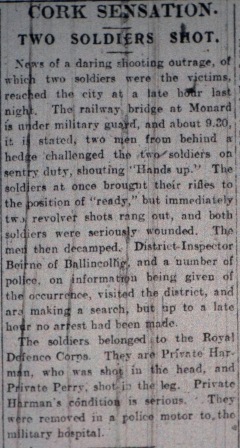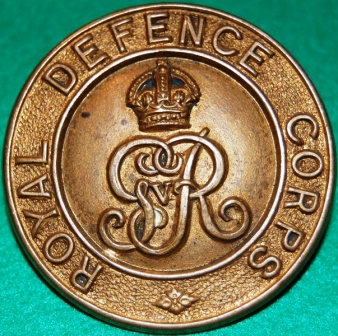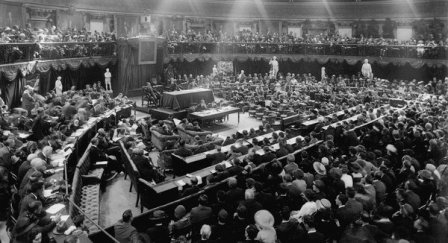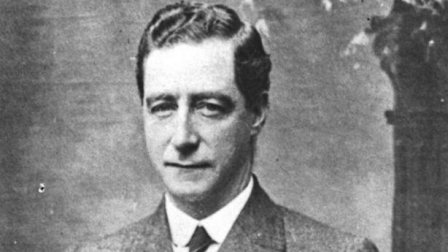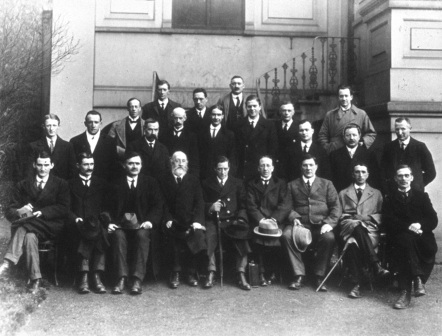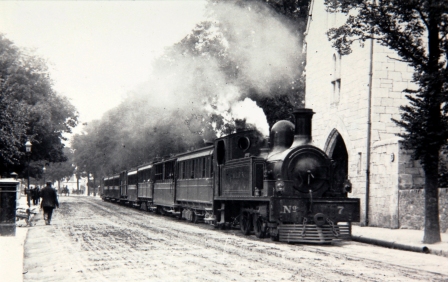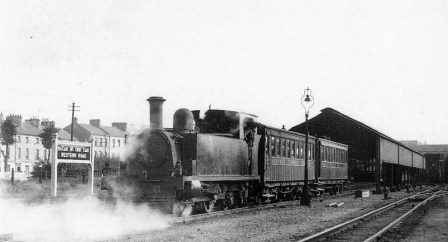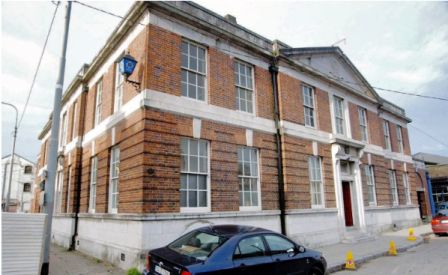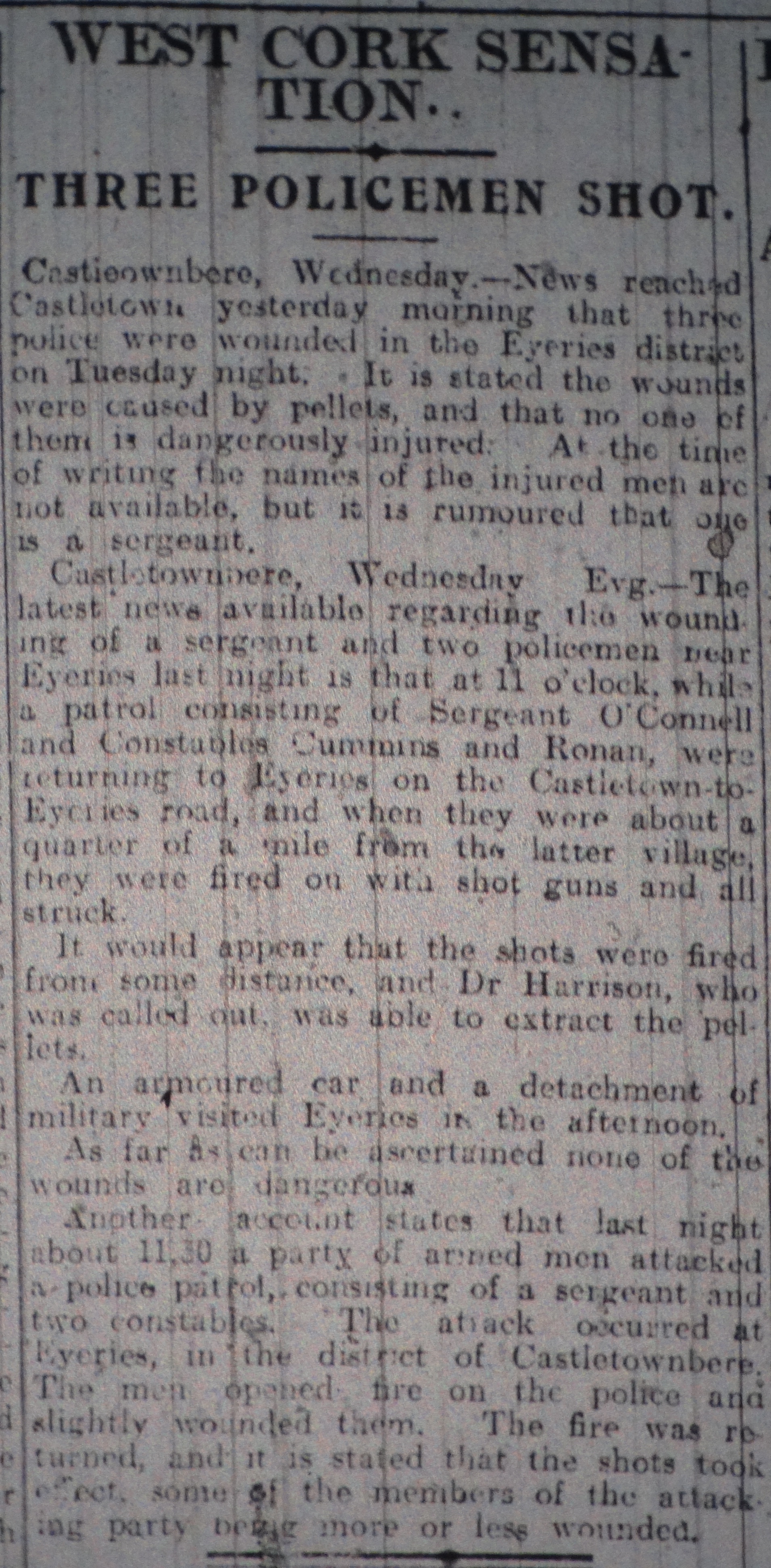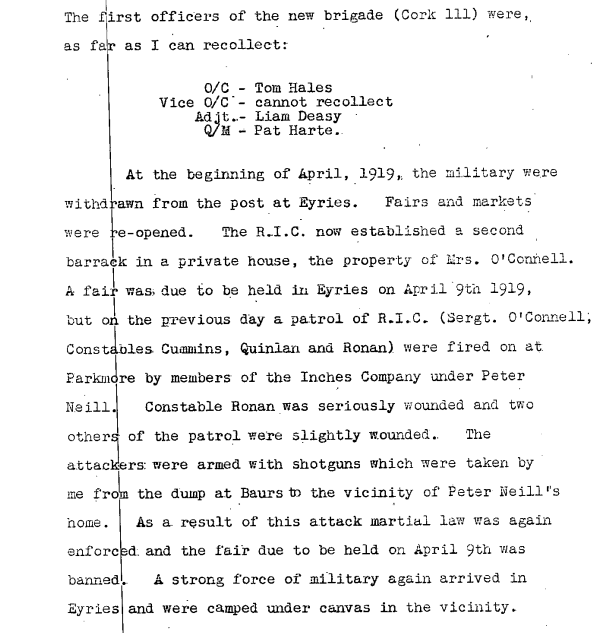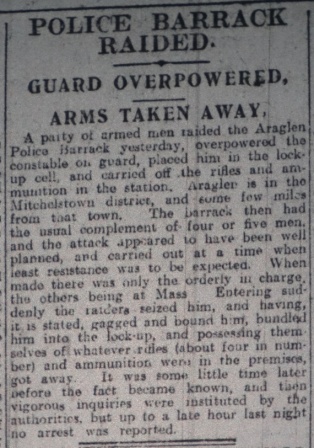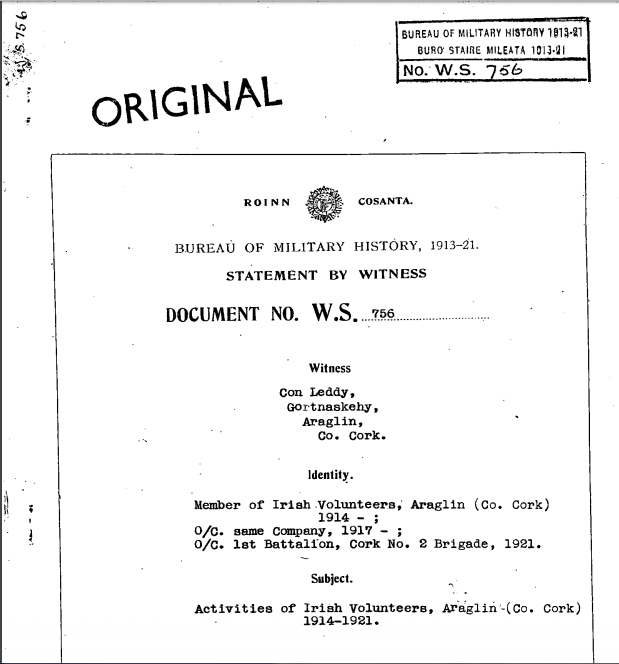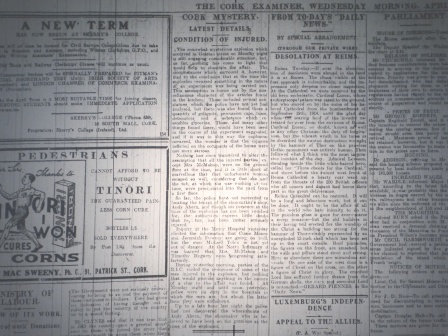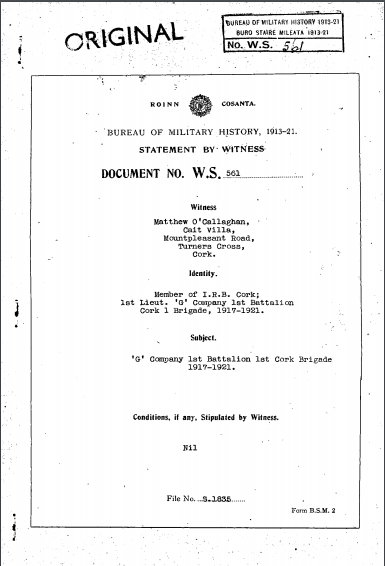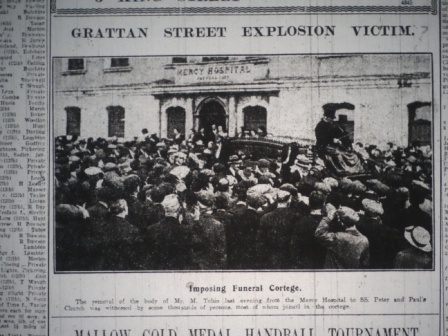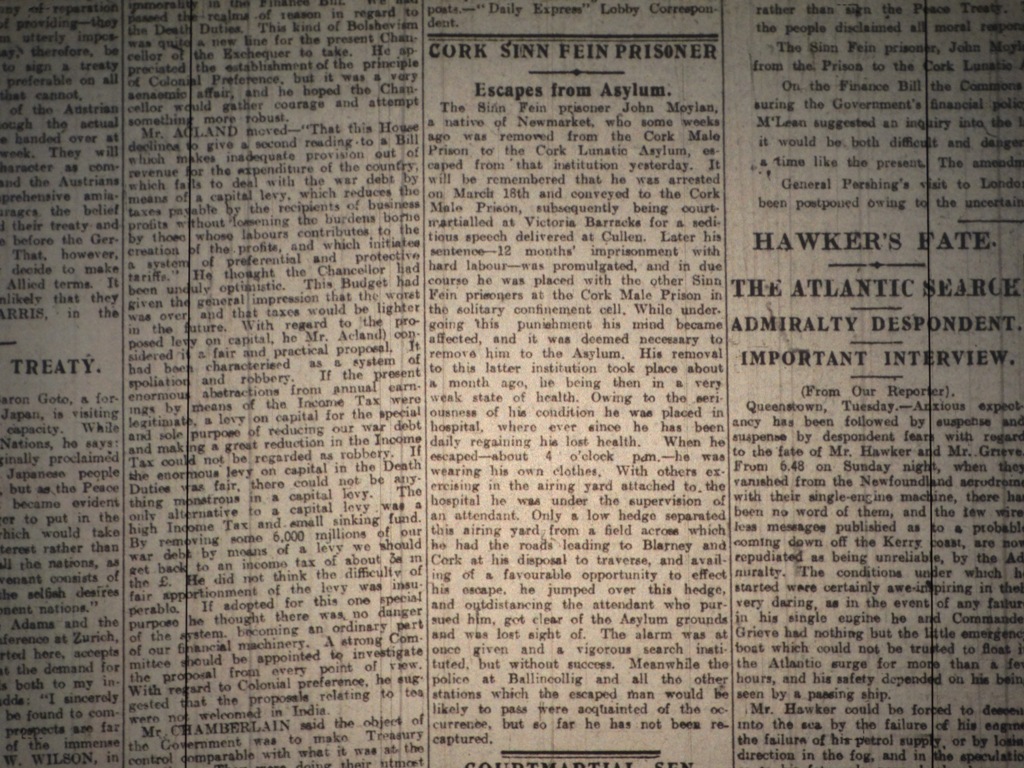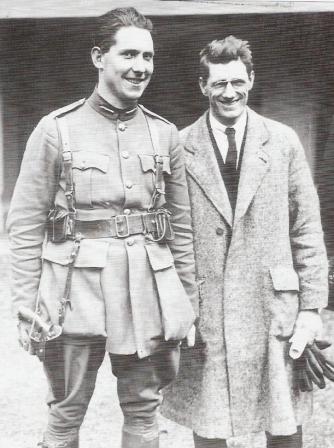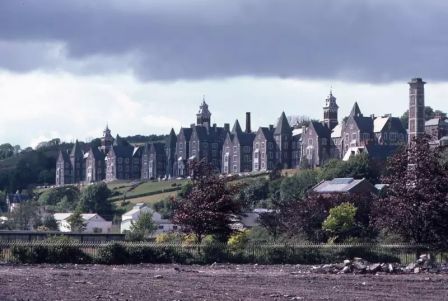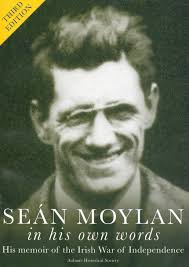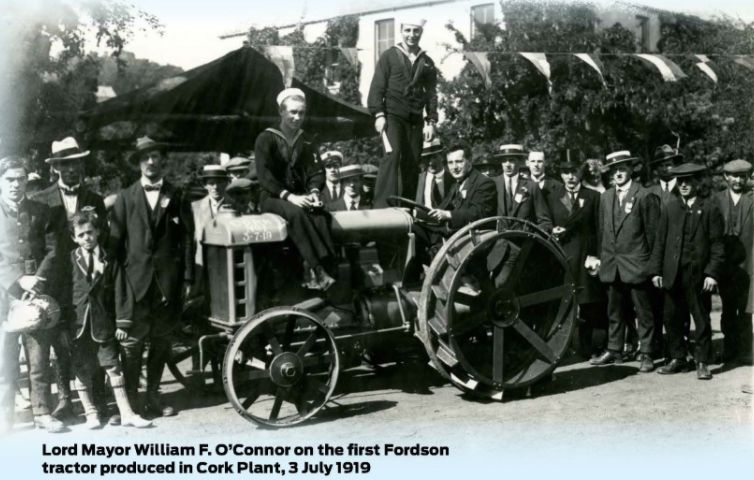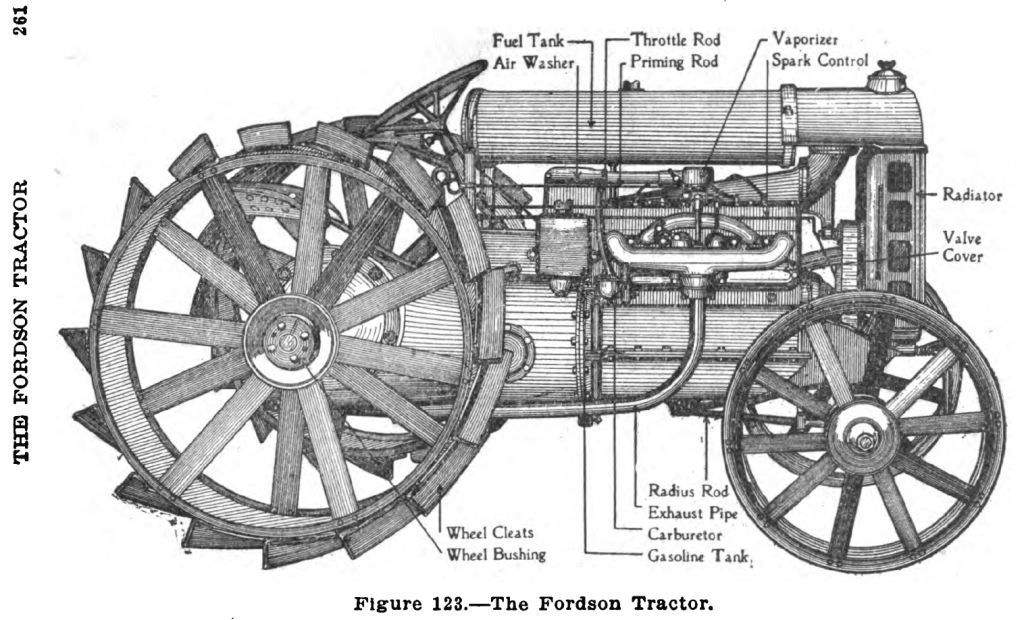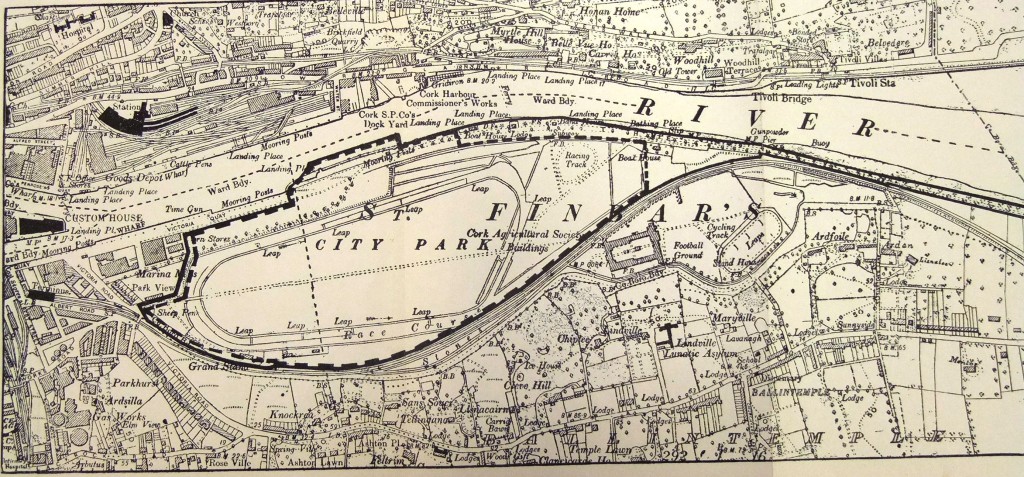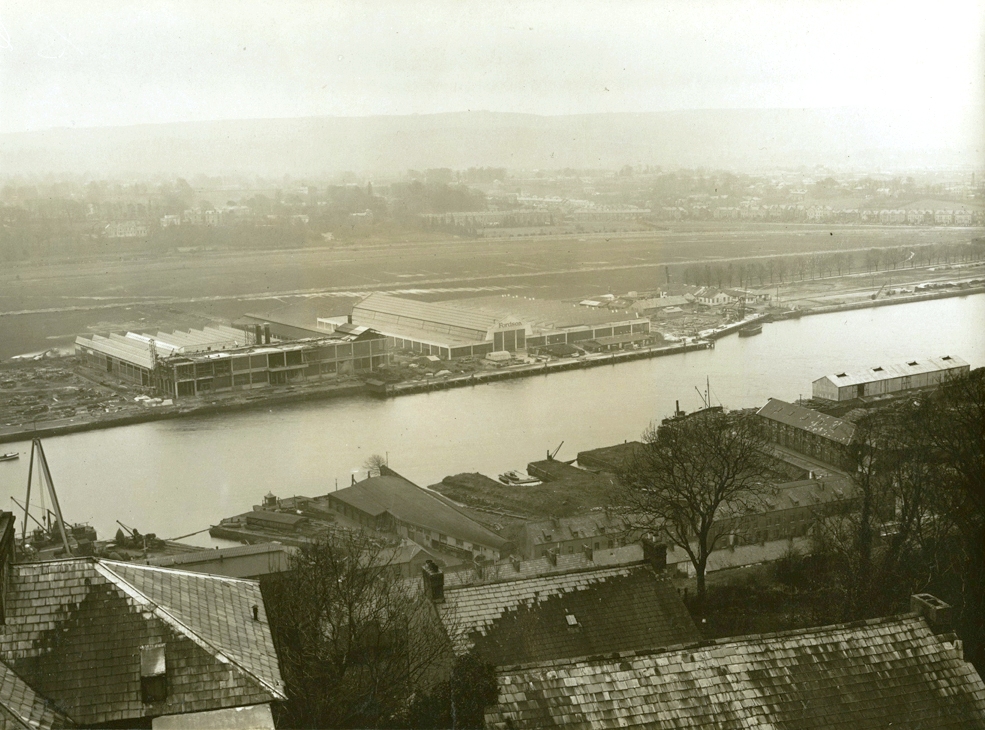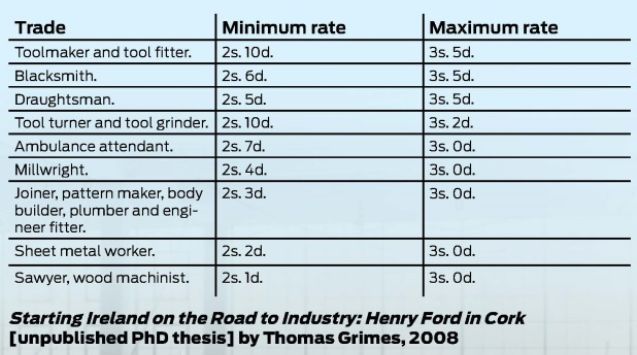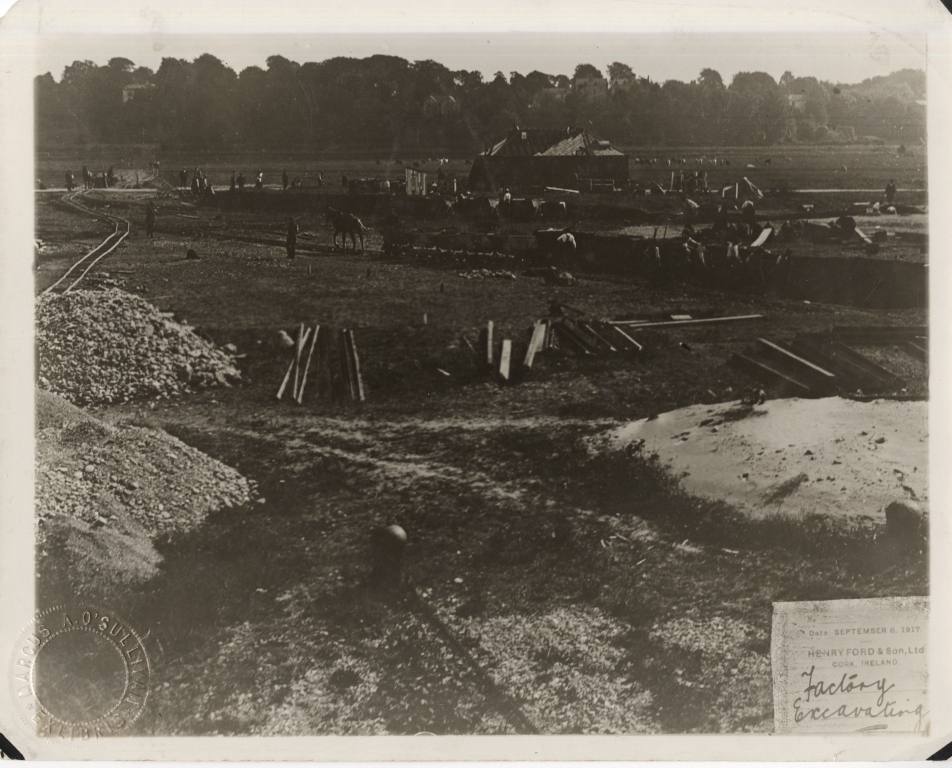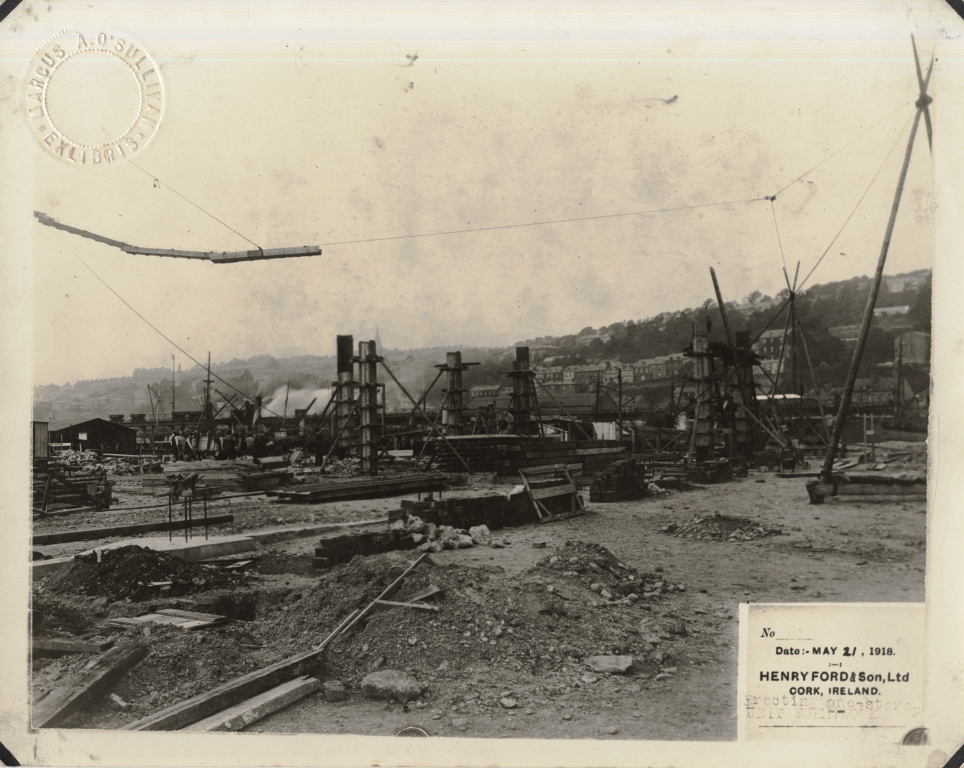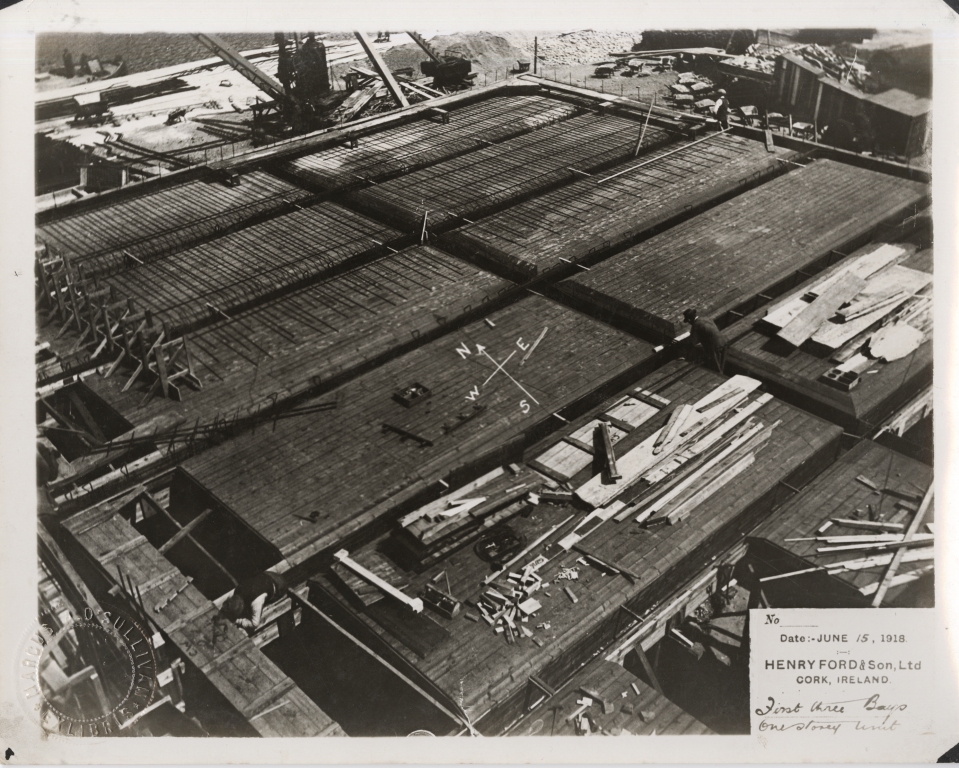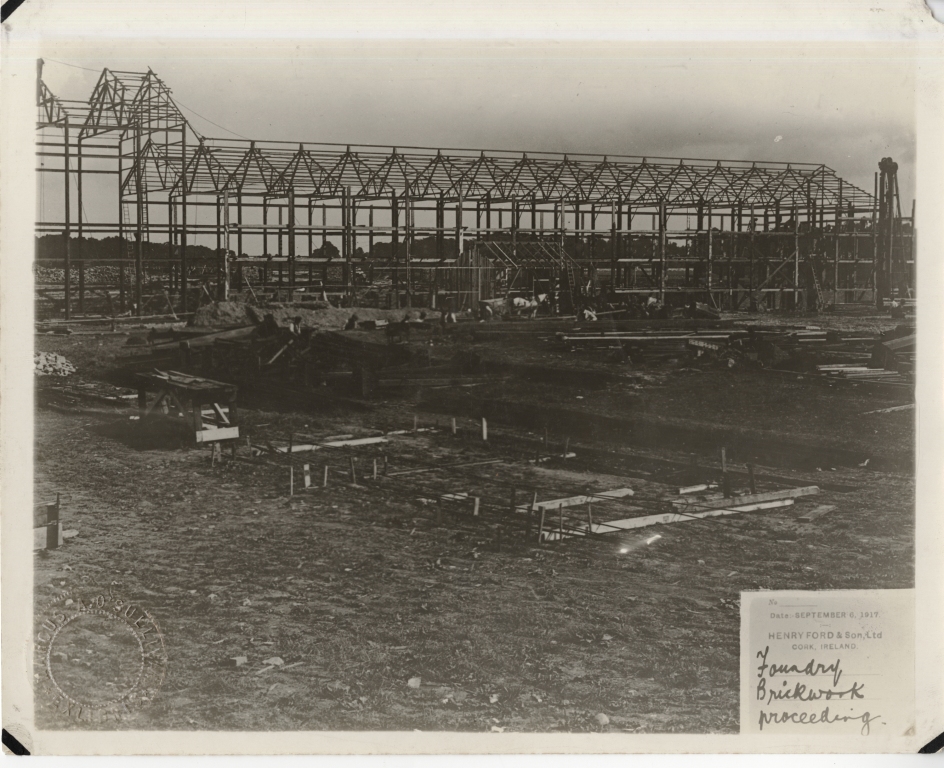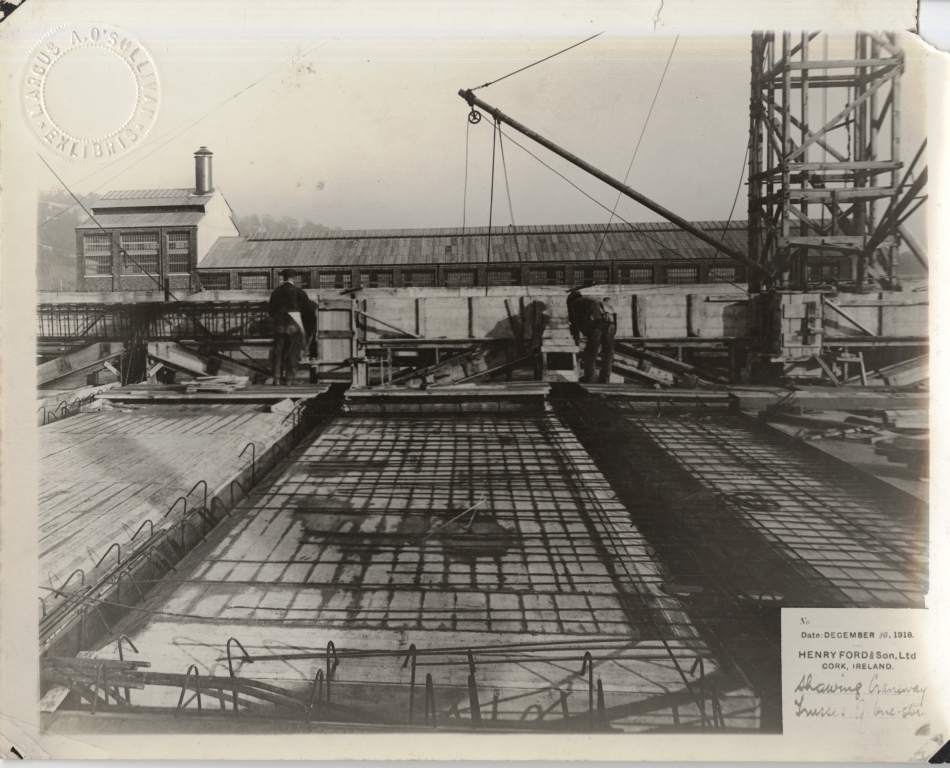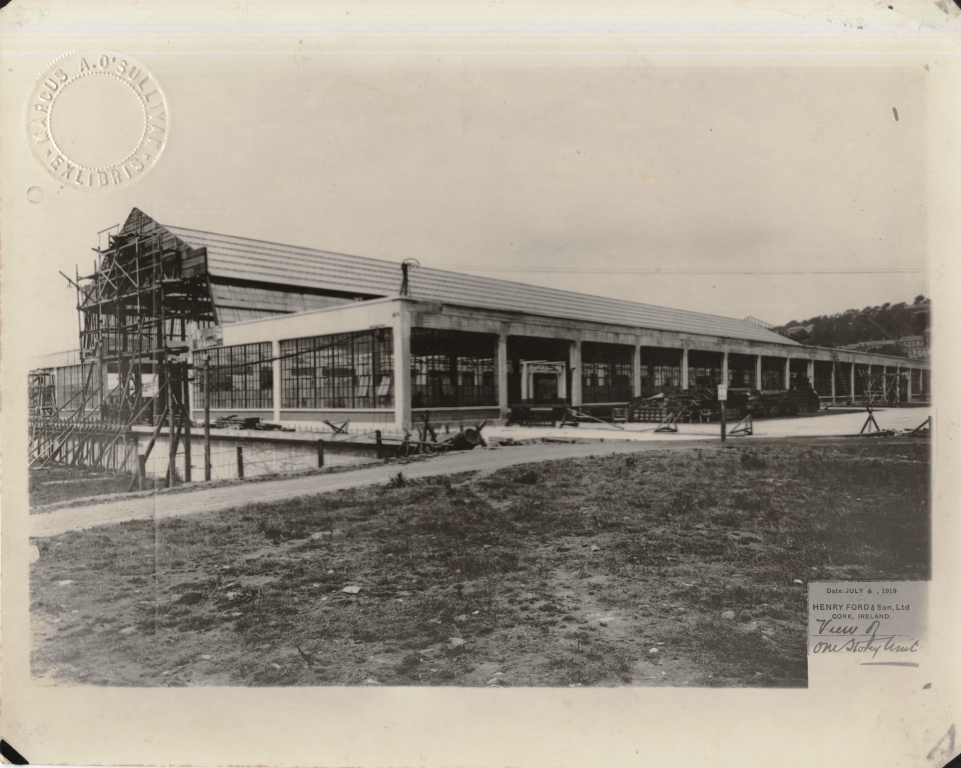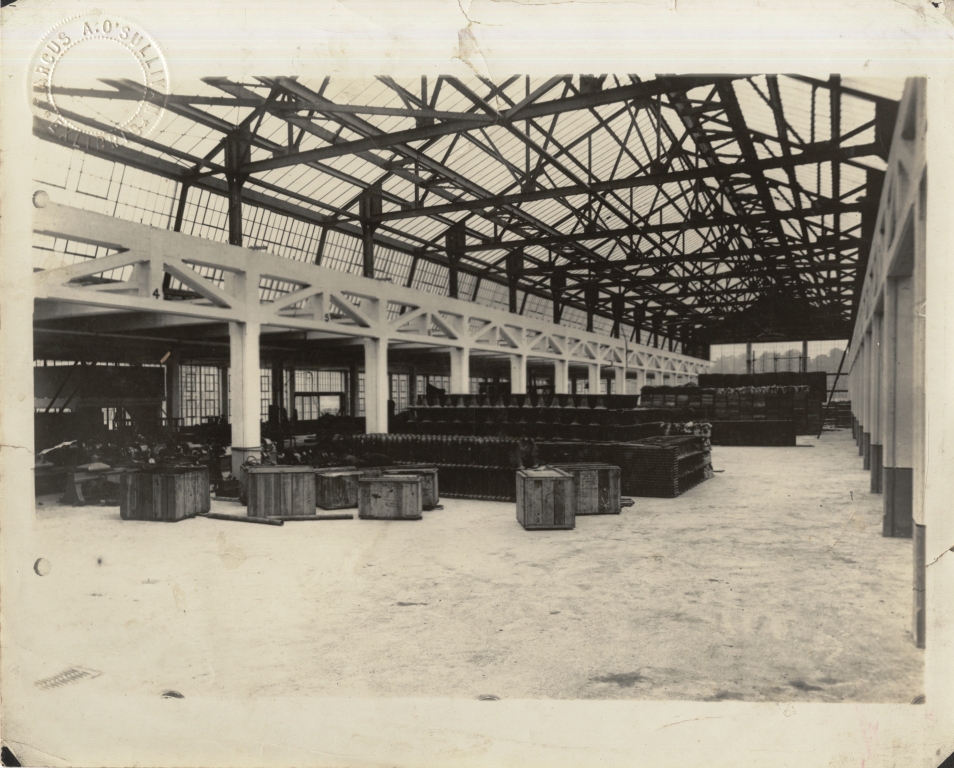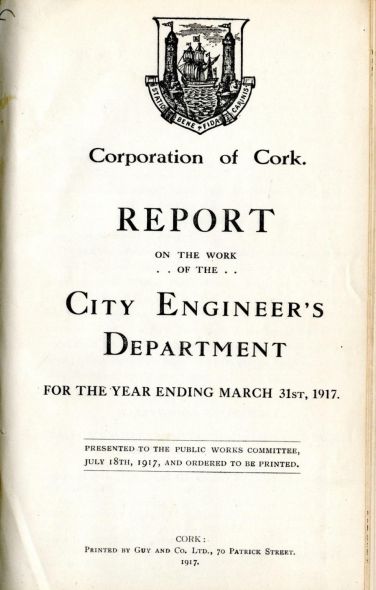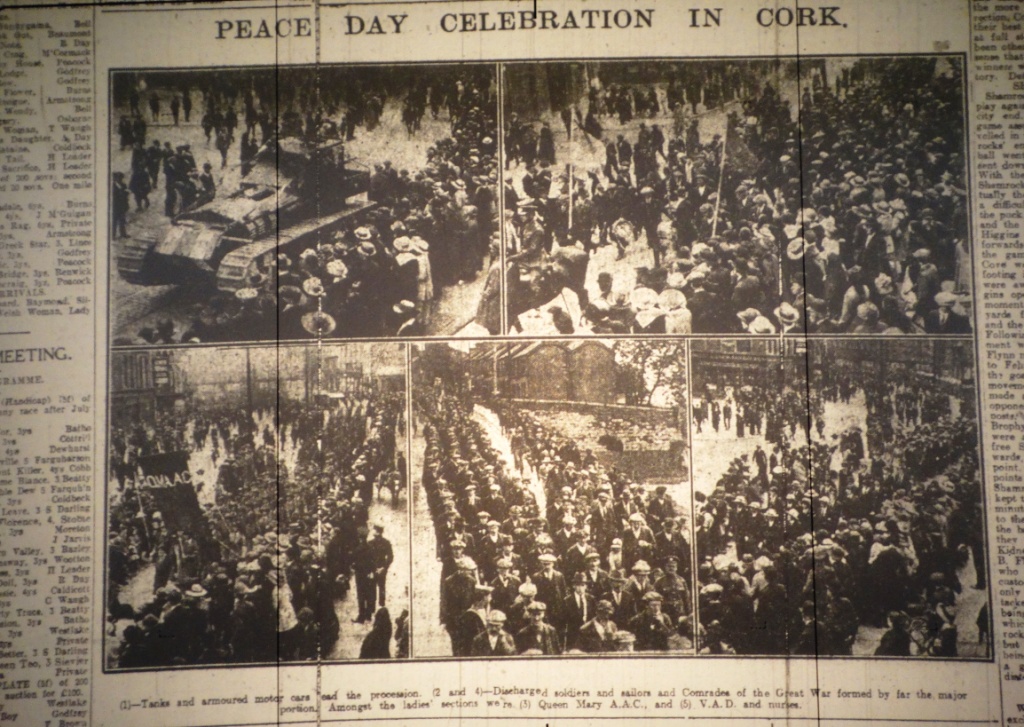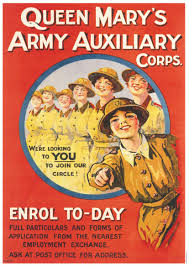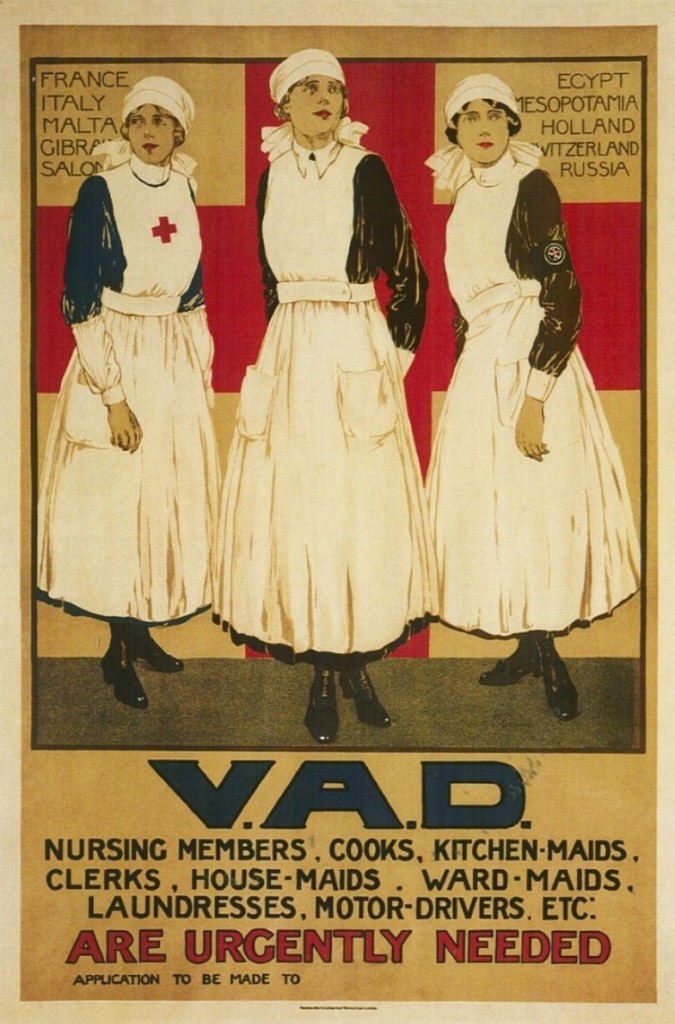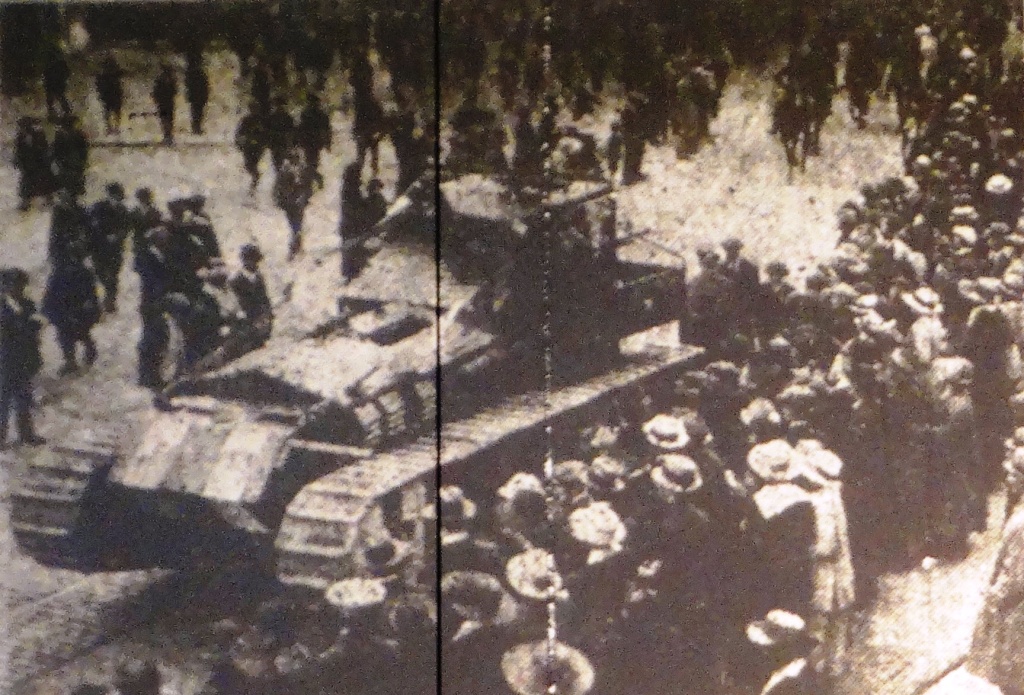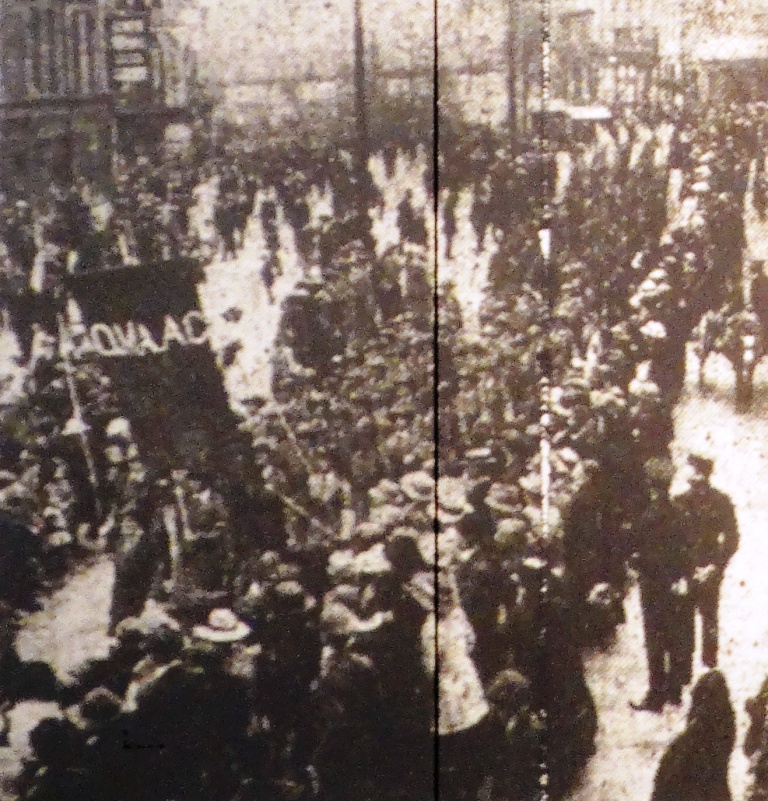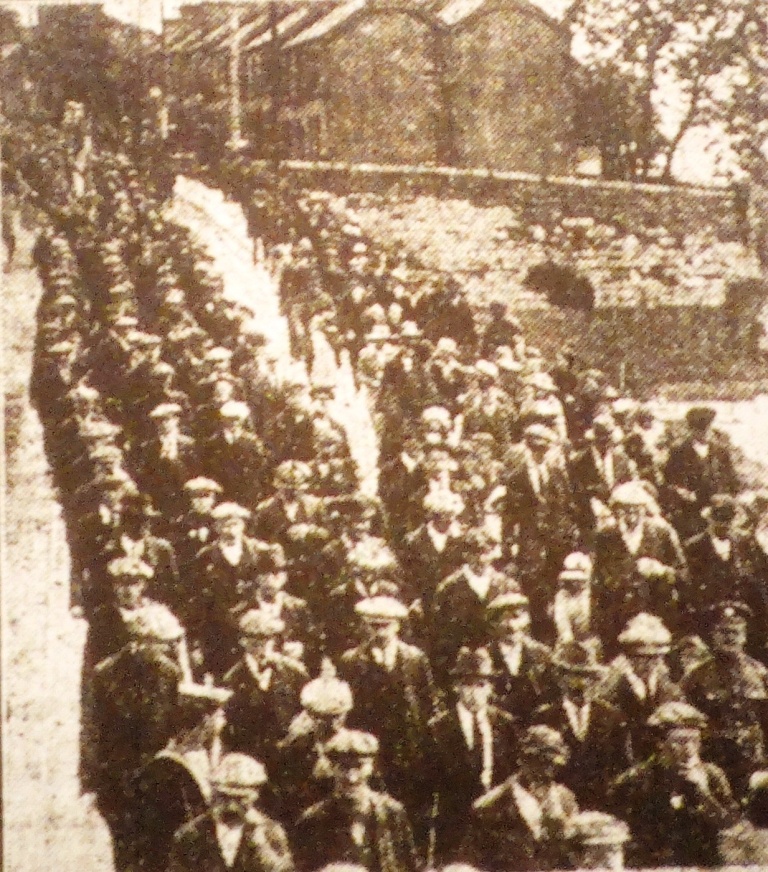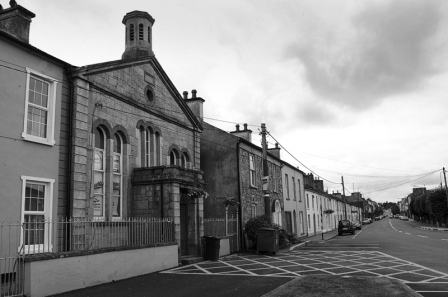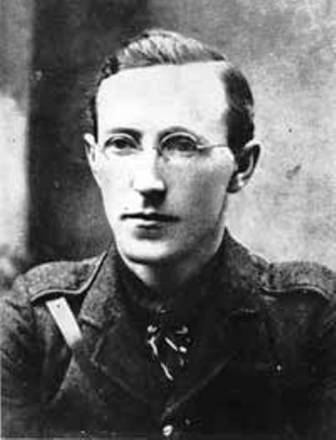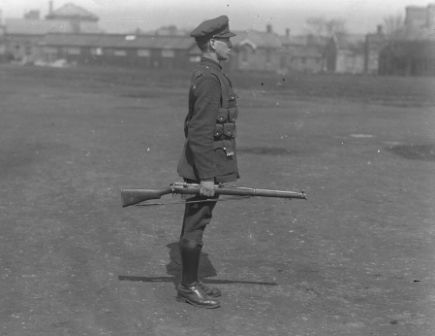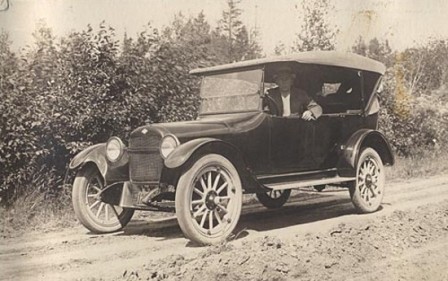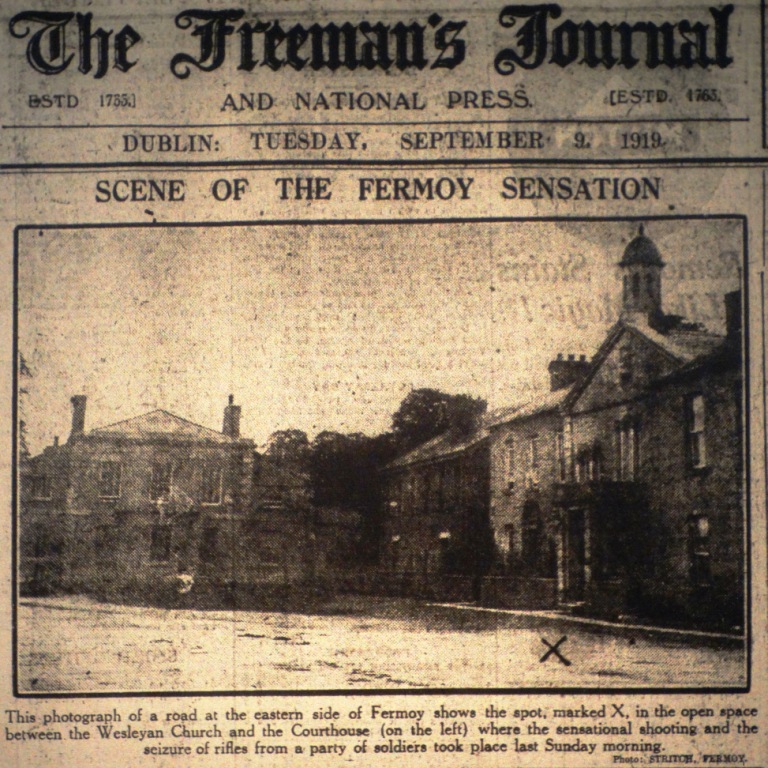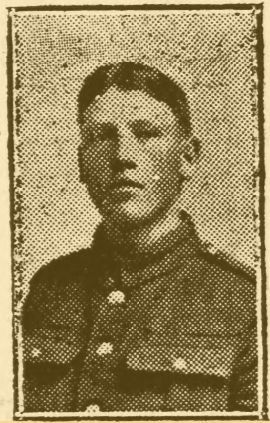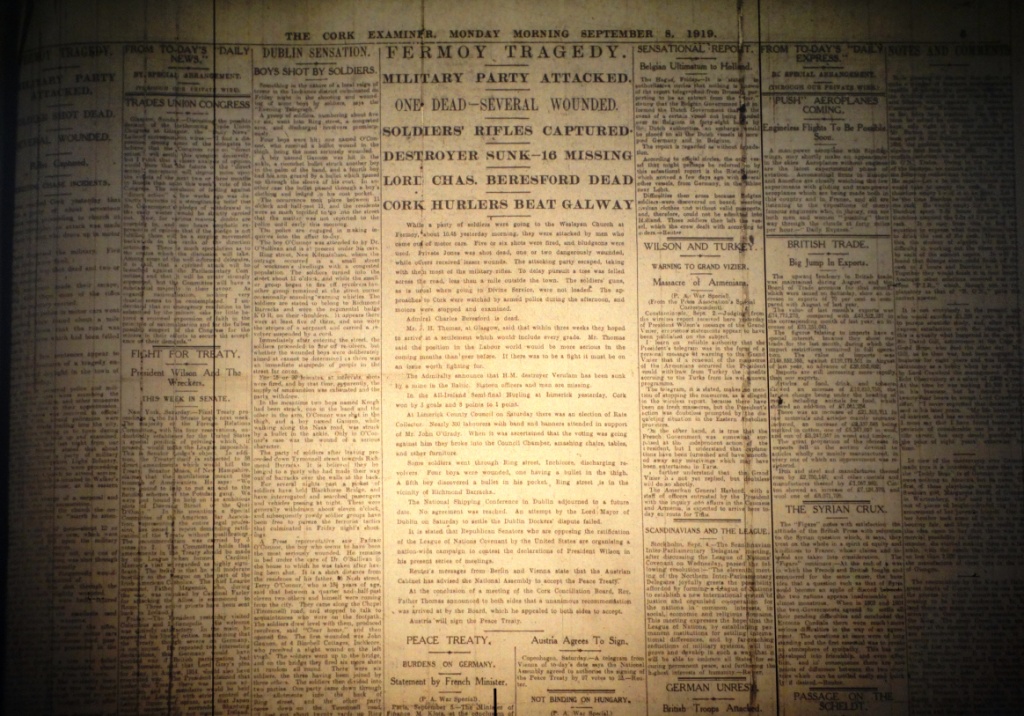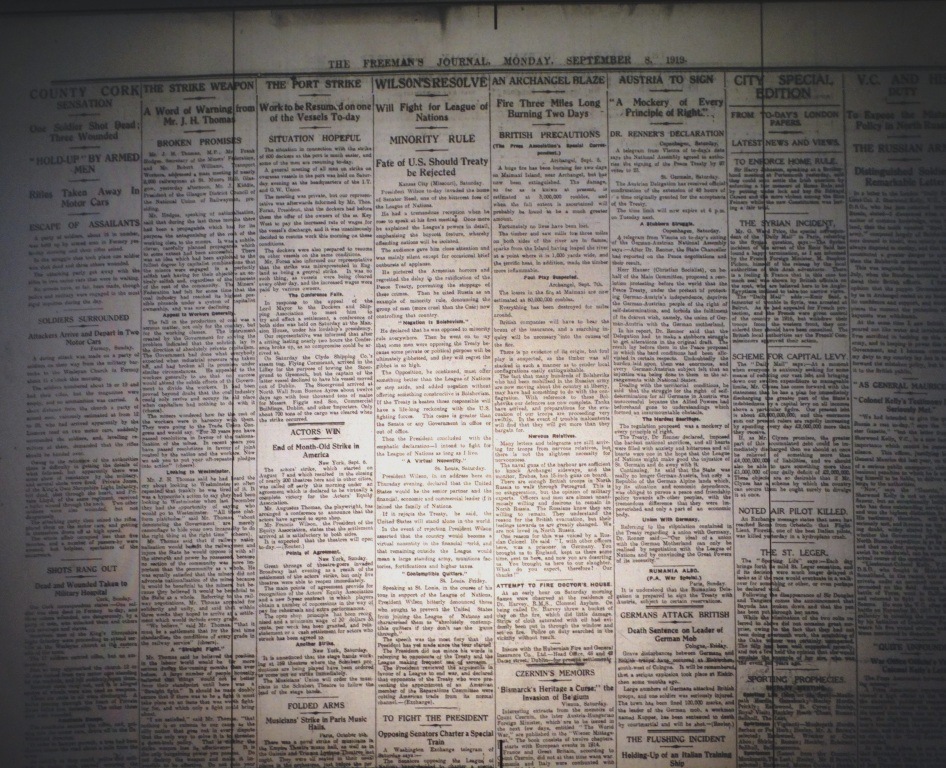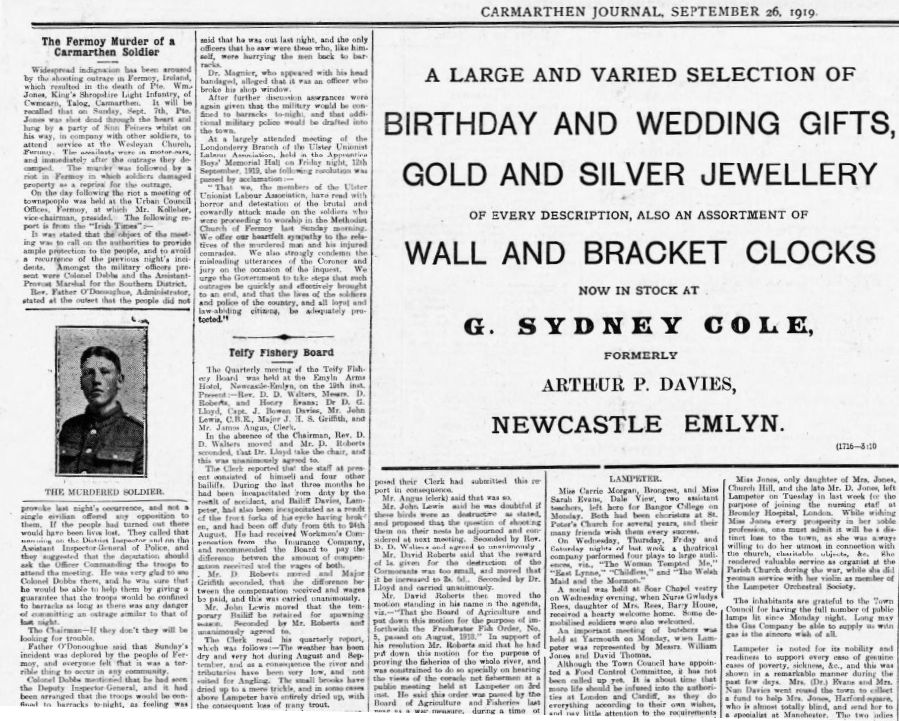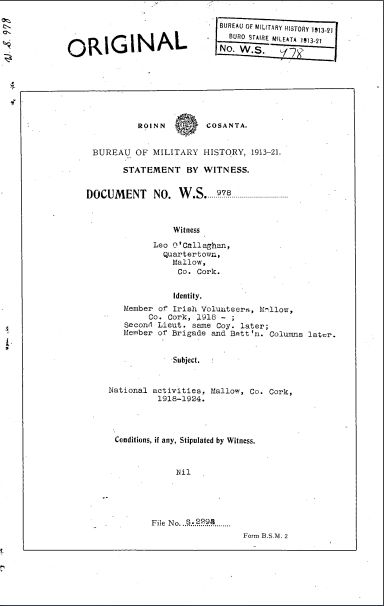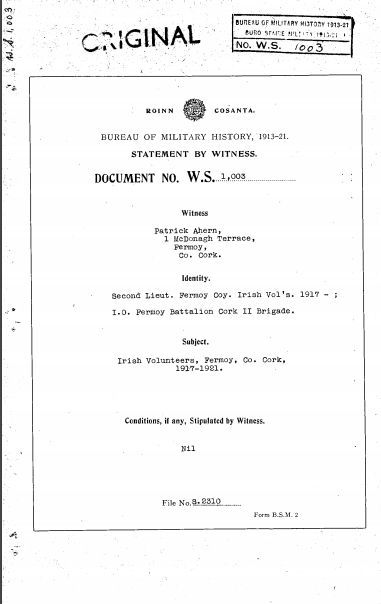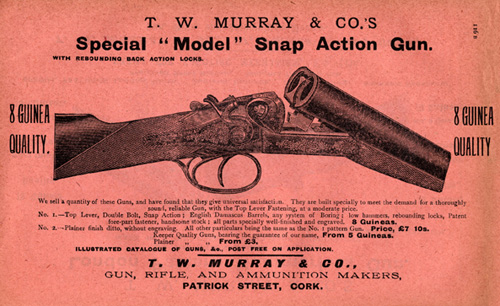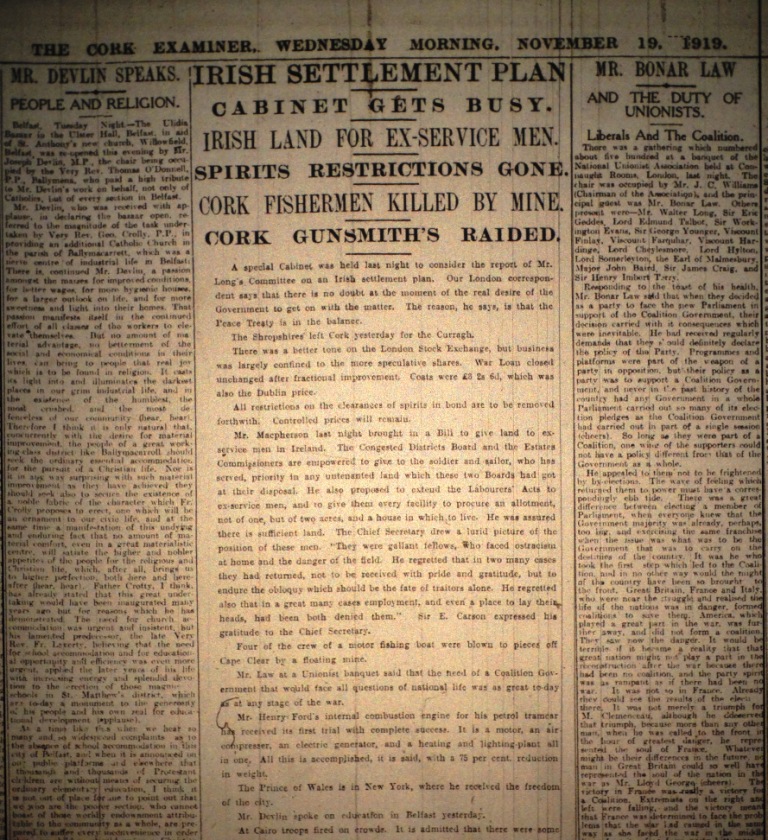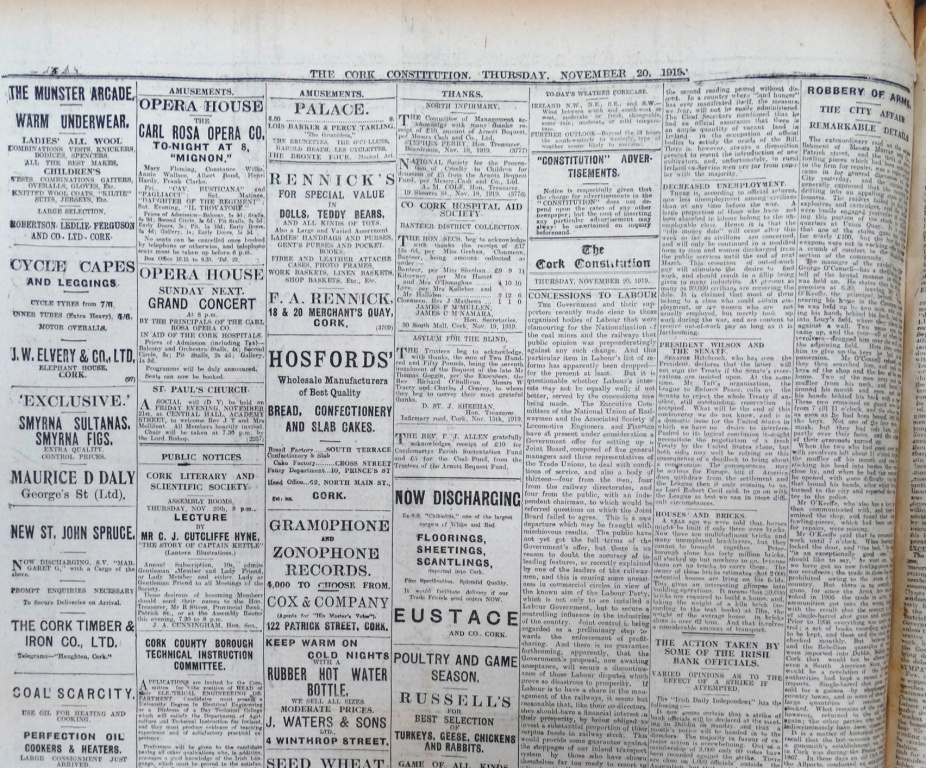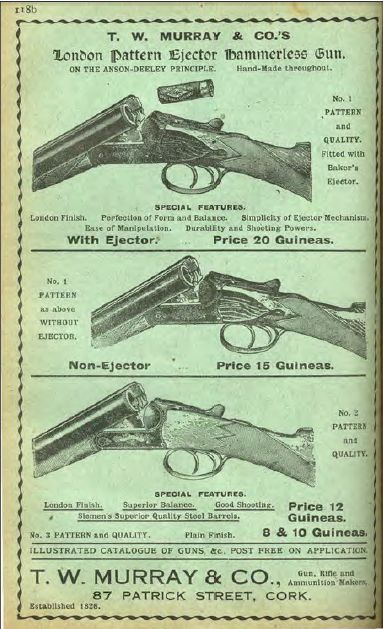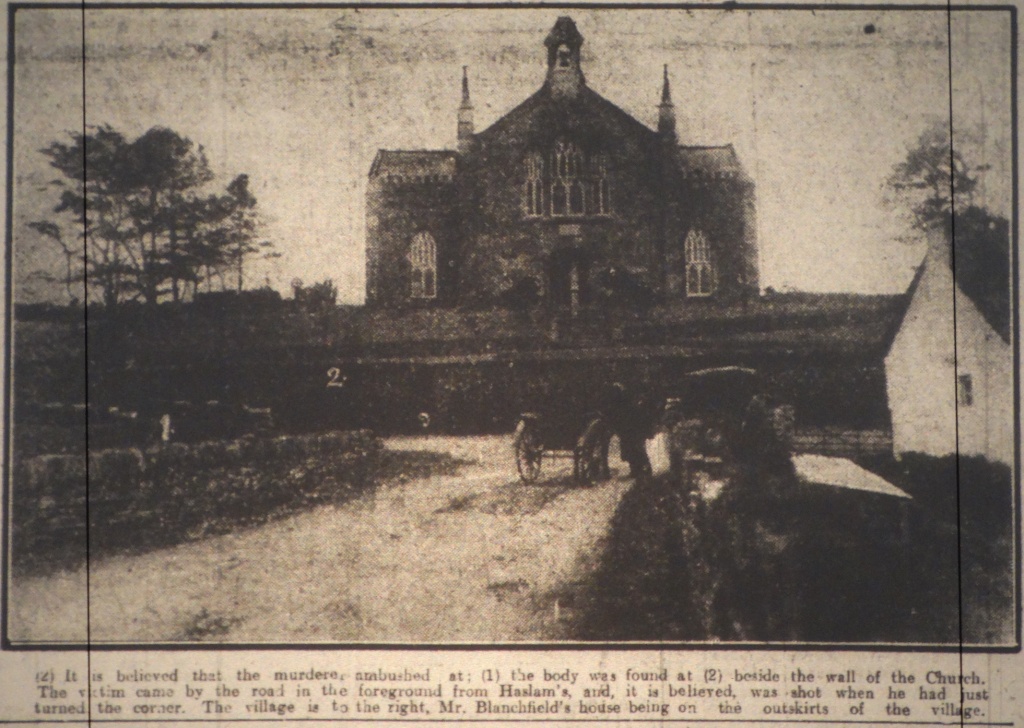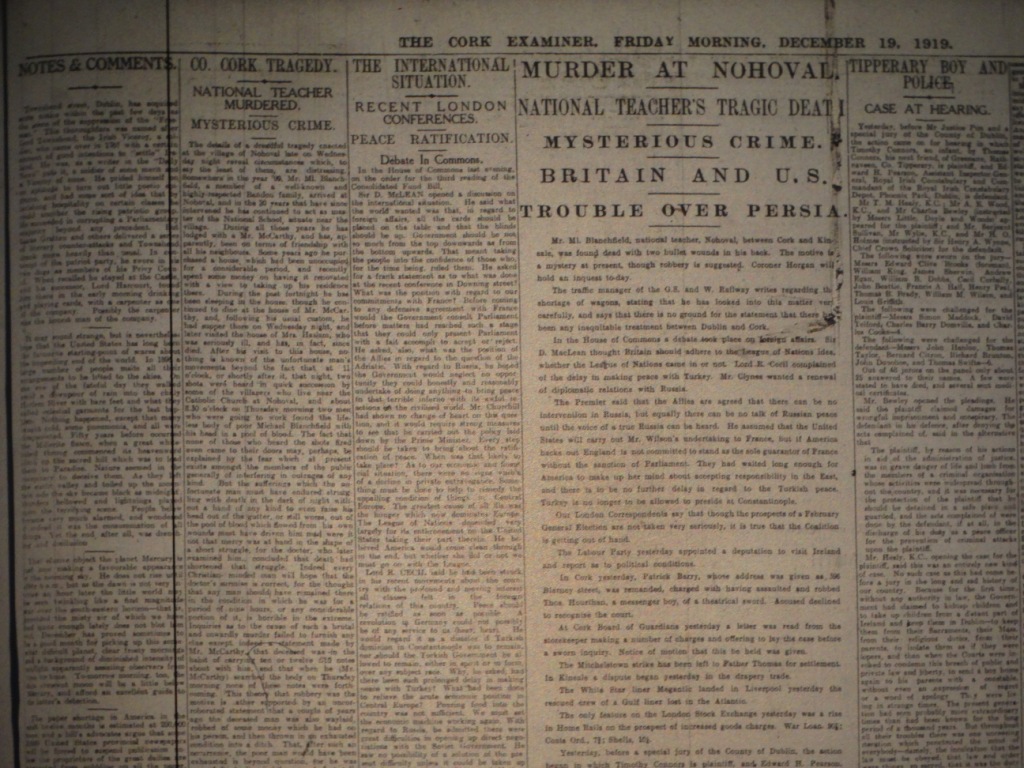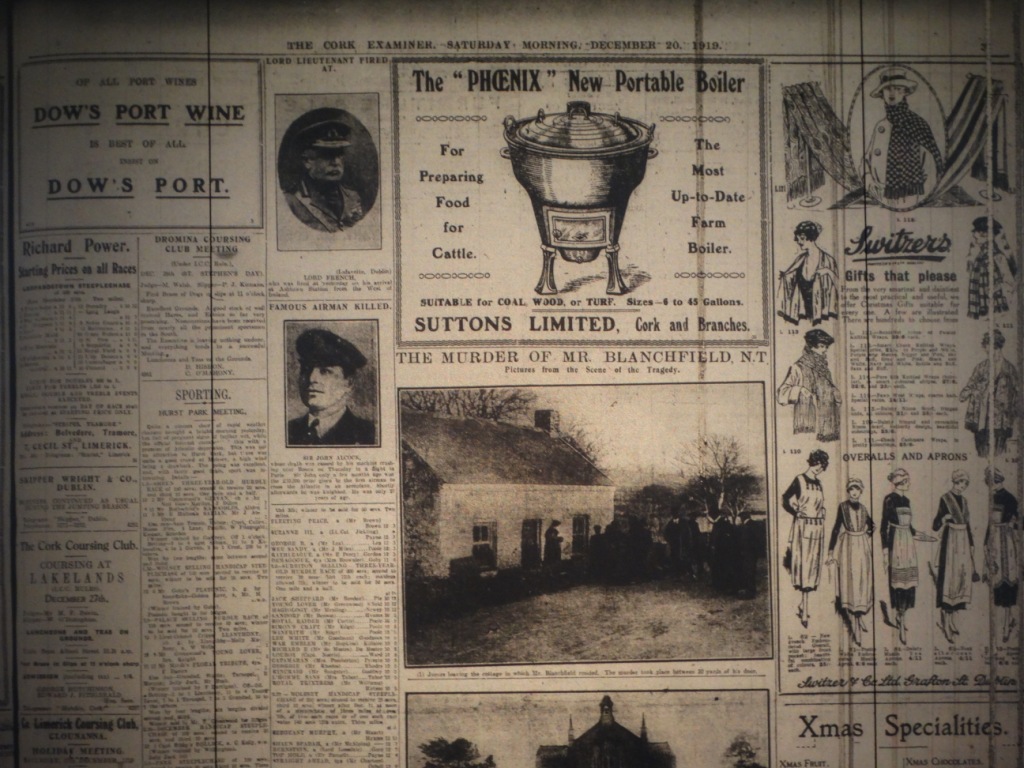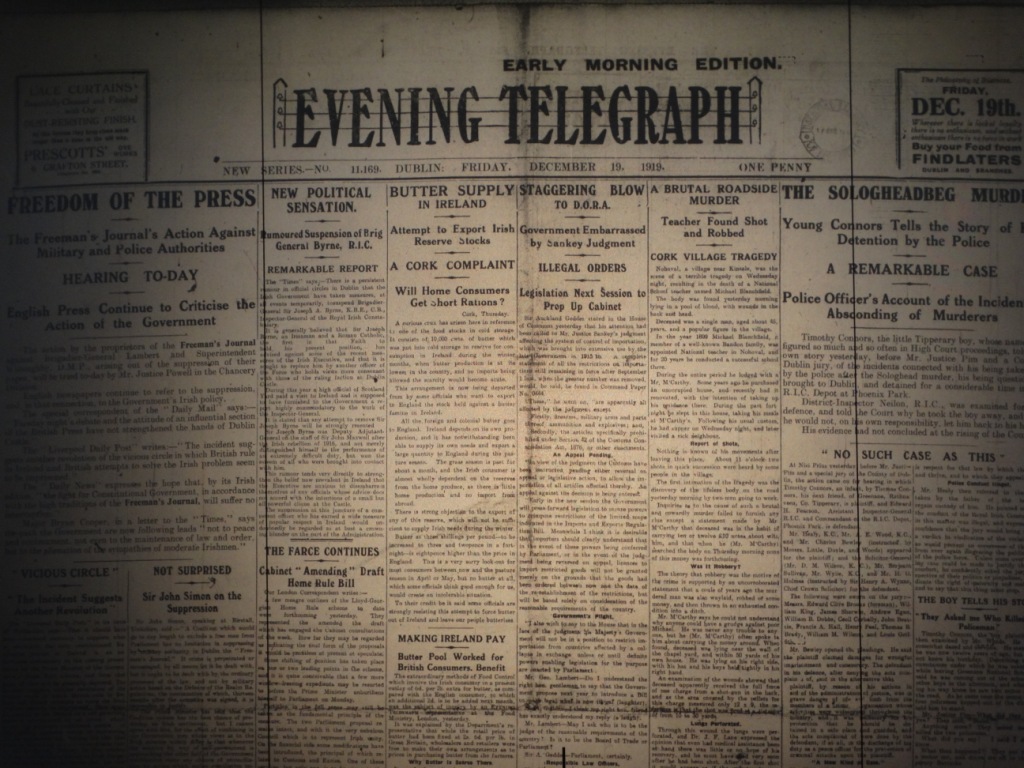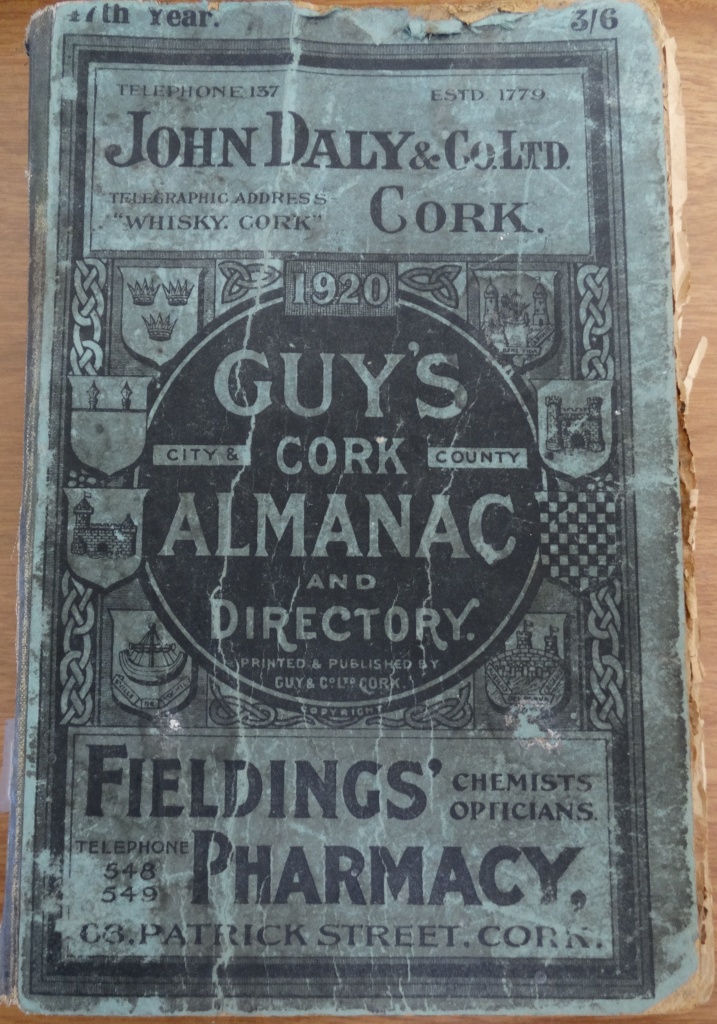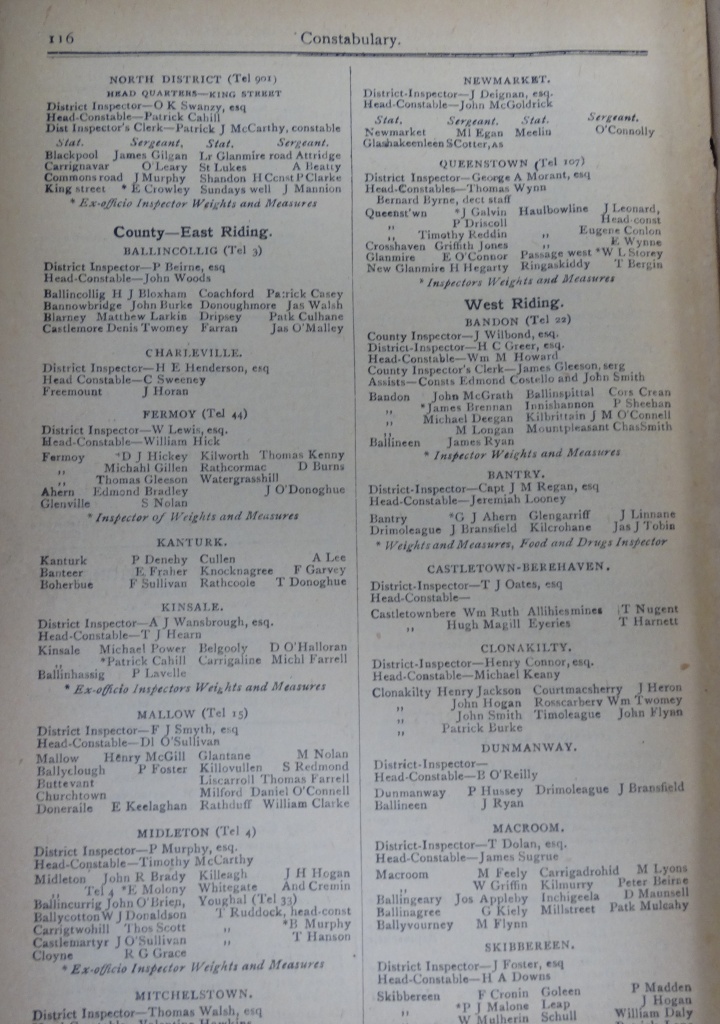-
Two RDC Soldiers Shot
Cork Examiner, 11 January 1919, page 4
January 10th, 1919On Friday the 10th of January 1919 two RDC (Royal Defence Corps) soldiers on sentry duty, were both challenged and then shot. This occured at 9.20pm at one of the railway bridges in Monard, County Cork.
The RDC was a security-like corps set up in August 1917 by the British Army. It comprised Home Service Garrisons, staffed by those who were medically unfit or too old for front line service. They were used as a small security force at selected locations.
-Royal Defence Corps
The two soldiers, Private Harman and Private Perry, were on sentry duty at one of the railway bridges at Monard when they heard two men from behind a nearby hedge shout out “Hands up”. The two soldiers brought to arms their rifles and at the same time they were met with revolver fire from the two men hiding in the hedge. Both soldiers were shot, Private Harman in the head and Private Perry in the leg.
District-Inspector Beirne of Ballincollig stated that Private Harman was in a serious condition but both men were not killed. He also stated that the attackers were not found and no arrests were made.
-
The First Dáil
January 21st, 1919On Tuesday the 21st of January 1919 the first Dáil met. This is also considered the first day of the War of Independence. It opened with a prayer spoken in Irish from Father Michael O’Flanagan and then was followed by initial business, which was also mainly conducted in the Irish language.
The first order of business was to appoint a speaker and clerks for the purpose of order and record taking. Cathal Brugha was appointed speaker of the first Dáil.
-Cathal Brugha
An interesting side note about this Dáil was the fact that twenty-nine names were recorded as present on the official roll, yet two of those names, Bolland and Collins, were actually on a rescue mission to free de Valera from prison. This may have been done to provide them with an alibi in case of an investigation and of course to circumvent attention away from the rescue.
It was recorded that 35 deputies of the 73 Sinn Féin members missing were “Imprisoned by the Foreigners”, an indication before the official announcement that the Dáil considered itself and Ireland independent from British rule. These members had been imprisoned by the English the year before because of the so called “German Plot”. There were 26 Unionist and 6 Parliamentary Party MP’s invited to the proceedings but all refused to take part.
The Dáil then read out the Declaration of Independence:
“Whereas the Irish people is by right a free people:
And whereas for seven hundred years the Irish people has never ceased to repudiate and has repeatedly protested in arms against foreign usurpation:
And Whereas English rule in this country is, and always has been, based upon force and fraud and maintained by military occupation against the declared will of the people:
And Whereas the Irish Republic was proclaimed in Dublin on Easter Monday, 1916, by the Irish Republican Army acting on behalf of the Irish people:
And Whereas the Irish people is resolved to secure and maintain its complete independence in order to promote the common weal, to re-establish justice, to provide for future defence, to insure peace at home and goodwill with all nations and to constitute a national polity based upon the people's will with equal right and equal opportunity for every citizen:
And Whereas at the threshold of a new era in history the Irish electorate has in the General Election of December, 1918, seized the first occasion to declare by an overwhelming majority its firm allegiance to the Irish Republic:
Now, therefore, we, the elected Representatives of the ancient Irish people in National Parliament assembled, do, in the name of the Irish nation, ratify the establishment of the Irish Republic and pledge ourselves and our people to make this declaration effective by every means at our command:
We ordain that the elected Representatives of the Irish people alone have power to make laws binding on the people of Ireland, and that the Irish Parliament is the only Parliament to which that people will give its allegiance:
We solemnly declare foreign government in Ireland to be an invasion of our national right which we will never tolerate, and we demand the evacuation of our country by the English Garrison:
We claim for our national independence the recognition and support of every free nation in the world, and we proclaim that independence to be a condition precedent to international peace hereafter:
In the name of the Irish people we humbly commit our destiny to Almighty God who gave our fathers the courage and determination to persevere through long centuries of a ruthless tyranny, and strong in the justice of the cause which they have handed down to us, we ask His divine blessing on this the last stage of the struggle we have pledged ourselves to carry through to Freedom.”
—Extract from minutes and Proceedings (Documents on Irish Foreign Policy)
-Note
The extracts have been translated and taken from the Minutes and Proceedings of the first Dáil of the Republic of Ireland 1919 – 1921. Documents on Irish Foreign Policy, Dublin (1994)
-
RIC Constable Shot On Western Road
March 30th, 1919On Sunday the 30th of March 1919 an attack took place on the Western Road in Cork City at the early hours of the morning. Two RIC constables were patrolling the road, one was shot through the hip with a revolver but suffered no life treating wounds.
The two Constable on duty were Constable Hayes and Constable Creed, stationed at the Corn Market Street Police Station.
During their rounds of inspections at the Cork and Muskerry Terminus, which was located on Bishop’s island, now the River Lee Hotel, they bid good morning to a man walking along the middle of the road. When the man did not reply they proceeded to stop and question him. Once they had stopped the man he began to mumble to the Constables and then produced a revolver.
-Train at station terminus Western Road
As the Constables tried to arrest the man holding the revolver he pulled away and in doing so fired three shots. The first two shots missed both Constables but the third shot hit Constable Hayes in the right hip.
While Constable Hayes lay injured, Constable Creed tried to restrain the man but he broke free and ran off in the direction of Hanover Street. Constable Hayes fired three rounds from his revolver at the man but they did not hit the man. Constable Creed gave chase while also firing his revolver an undisclosed number of times.
Local residents along Hanover Street stated that they heard loud noises like gunfire and men shouting “Catch him!” “Catch him!” as the man disappeared from view. Constable Creed returned to Constable Hayes to aid him with his injuries and assist him in reaching the Mercy Hospital. Once the Constables had reached the Mercy Hospital they reported the incident to Head Constable William Butler, who then organised a search of the area, the shooter was never found.
Constable Hayes was operated on by Dr. Dundon on the Monday of the 31st in order to remove the bullet. Constable Hayes made a full recovery.
- Bridewell RIC Station
The above information has been taken from The Cork Weekly Examiner, 5 April 1919, page 3.
-
RIC Patrol Shot in Eyeries
April 8th, 1919On Tuesday 8th of April 1919 an attack took place in the Eyeries district, in a place known as Parkmore, which is 7 kilometres north of Castletown-Bearhaven. Four RIC Constables were attacked and three were wounded at around 11pm as they were patrolling the area. There was to be a fair and market held the following day.
The RIC on patrol were Sergeant O’Connell, Constable Cummins, Constable Quinlan and Constable Ronan who were returning to their barracks in Eyeries along the Castletown-Bearhaven to Eyeries road. They were intercepted by members of the Inches Company under Peter Neill who opened fire with shotguns. Constable Ronan was seriously wounded, with Sergeant O’Connell and Constable Cummins taking minor injuries. Once the majority of the patrol was incapacitated, the Inches Company then evacuated the area. The shotguns used in the attack were previously stored in an arms dump at Baurs in the vicinity of Peter Neill’s home and were gathered up by James McCarthy for the purpose of arming the Inches Company.
-James McCarthy witness statement
An armoured car and detachment of soldiers arrived on site in search of the Inches Company but were unable to locate any of the men involved. This lead to the area being placed under martial law and the market fair the following day was cancelled.
The above information has been sourced from The Cork Weekly Examiner, 10 of April 1919, page 3.
Witness statement of James McCarthy was sourced from the (Link) Bureau of Military History 1913-1921 (No. W.S. 1567, page 8)
-
Raid On Araglen RIC Barracks
April 20th, 1919On the morning of Sunday the 20th of April 1919, there was an organized raid on the RIC Barracks in Araglen by the Volunteers. The raiders made off with a number of rifles and ammunition with no loss of life or injuries.
-Map Data 2017 Google Maps
Early in 1919 a recommendation to raid the Araglin RIC Barracks in Co. Cork was made by members of the Irish Volunteers of Araglin. The officer commanding was Con Leddy and the recommendation was sent to Liam Lynch, who as the Brigade 0.C., for approval. Once the plan was approved the Volunteers organized the raid to take effect on the Sunday morning while a majority of the RIC Constables in the Barracks would be away at mass.
On the morning of Sunday, 20 April 1919, a company of seven Volunteers made their way towards the RIC Barracks wearing masks in order to hide their identities. The Volunteers were named in a witness statement by the O.C Con Leddy as, Michael Fitzgerald, Con Leddy (himself), Seán Mahony, Tom Brennan, Owen McCarthy, Maurice Hyland and John Donovan. They approached the barracks at the rear in order for a surprise attack. One of the volunteers looked through the window and established that there was only on RIC Constable on duty, Constable O’Malley.
When Constable O’Malley left the safety of the barracks to fetch a bucket of water, the Volunteers went inside to secure any arms and ammunition they could find. They managed to locate and secure four rifles, a revolver and two hundred rounds of ammunition. The Volunteers themselves were armed with two revolvers carried by both Con Leddy and Mick Fitzgerald, while the rest of the Volunteers were armed with shot guns.
On Constable O’Malley’s return to the barracks he noticed the Volunteers inside the barracks and on doing so tried to throw the bucket of water at the Volunteers to allow for an escape. He fell. Con Leddy placed his revolver at point blank range into Constable O’Malley’s ribs securing the prisoner and the barracks. Constable O’Malley requested that the Volunteers fire a few shots from their revolvers into the stairs and then gag him so that his Sergeant and the other Constables would get the impression he had put up a fight in defence of the barracks. Con Leddy obliged this request and stated that the young Constable was not stationed in Araglin very long and later did not make any effort in identifying them.
Apart from the rifles and ammunition the Volunteers also secured books and records of the barracks but later destroyed them as they had no importance to Volunteer activities.
The district inspector and a number of RIC came from Fermoy to investigate the raid but after a week they were no arrests made and no recovery of the taken rifles and ammunition. Con Leddy states that his home was raided along with two other volunteers but nothing was found.
The above information has been sourced from The Cork Weekly Examiner, 21 April 1919, page 4.
Witness statement of Con Leddy was sourced from the (Link) Bureau of Military History 1913-1921 (No. W.S. 756, page 6)
-
Grattan Street Bomb Factory Explosion
April 28th, 1919On the night of Monday 28 April 1919, an explosion took place in a make shift bomb factory at 33 Grattan Street Cork City. At the time the Cork Examiner and local authorities believed it to be an experiment The premises was belonged to a man named Andy Ahern who used the bottom floor as a shoe shop, and most of the substances were not identified right away.
The injured man was identified as Lieutenant Michael Tobin, an officer of G company of the First Battalion in the Cork No.1 Brigade of the Irish Volunteers. He died from his injuries nearly a month later on the 20th of May.
The explosion occurred while the Volunteers were in the process of moving explosives to a secure location, after hearing that police were searching nearby. During the process of emptying the explosive powder from storage tins into coarser linen bags, a build up of heat, ignited the explosive material. Luckily there was only powder in the bags and no shrapnel, but three Volunteers were badly injured Lieutenant Michael Tobin subsequently died. The three men working on emptying the explosive material were Company Captain Dick Murphy, Lieutenant Michael Tobin and Sean O’Connell, who later gave a witness statement to the Bureau of Military History (See Seán O’Connell’s WS 1706, 3-4). There were three more Volunteers, P. Varian, and F. Downey and Miss C. Moore on the premises at the time but were in the next room and safe from the main explosion. They also sustained injuries.
Lieutenant Michael Tobin passed away on the 20th of May and his remains where removed from the Mercy Hospital to the City church (SS. Peter & Paul’s) on the 21st of May. His remains were escorted by a large number of Volunteers, Fianna Boy Scouts, Citizen Army Boy & Girl Scouts, Cummann na mBan, the Clan na nGaedheal Girl Scouts and a large number of civilian mourners. The procession moved along Western Road, Great Georges Street, Grand Parade, South Mall, Winthrop Street, Pembroke Street, and Patrick Street. The hearse was lead by fellow Volunteers and was followed by a pipe band. Lieutenant Michael Tobin was then laid to rest in his family burial ground near Ballineen.
-Tobin’s burial
From Cork Weekly Examiner, 30 April 1919, page 6 and 23 May 1919, page 3.
Witness statement was sourced from the (Link) Bureau of Military History 1913-1921 (No. W.S. 1706, page 3-4)
-
Seán Moylan’s escape from Cork Lunatic Asylum
Cork Weekly Examiner, 21 May 1919, page 4
May 20th, 1919Seán Moylan, a native of Newmarket, was arrested on the 18th of March in 1919 for a seditious speech at the town of Cullen. He was sentenced to twelve months hard labour at the Cork men’s Prison by court-martial at Victoria Barracks, now known as Collin’s Barracks. He was then moved to the Sinn Féin prison section, Number 10 Wing, in the Cork City Male Prison and placed in solitary confinement. It is here Seán Moylan decided to begin his hunger-strike in order to gain his freedom.
-Seán Mc Keon (left) & Seán Moylan (Right)
During his hunger-strike he was threatened, abused and ridiculed by the warders but as time went by, the warders tried to woo and tempt him with specially prepared delicacies in hope of breaking his hunger-strike. Due to his weakened and emaciated state he was removed to the prison hospital. Seán Moylan states in his memoirs that the warders placed him by the fire while they made up a bed for him.
There Seán Moylan was approached by another prisoner, Martin Beckett of Kilgarvan, who he described as an 'incorrigible practical joker' .
After Seán Moylan told Martin Beckett of his intension to hunger-strike until he was released, Martin Beckett gathered other prisoners around him and faced the warders in order to initiate the first step of the escape plan. Martin Beckett declared loudly “We’re not going to stop in this damn place, we know what this chap is and what’s wrong with him”, speaking of course about Seán Moylan to the warders, “He’s dangerous, he’s a lunatic and every relation of his died in a lunatic asylum”. In order to enhance this claim Martin Beckett collected all the tongs, pokers and every possible weapon, giving them to the warders while expressing his insistence of them removing said items for safety. This lead the warders to question Seán Moylan’s sanity and call for the prison Governor and prison Doctor to investigate. Cork City Lunatic Asylum was less fortified than the Cork City Male’s Prison and would allow for an easier escape.
When the prison Governor and prison Doctor questioned Martin Beckett about his accusations, Martin Beckett compared Sean Moylan and his family to Henri Désiré Landru, a French serial killer, and Jack the Ripper. Seán Moylan added to this subterfuge by not speaking and snarling when touched. Within a short time of the Governor’s and Doctor’s arrival they both left the room and placed a warder outside the door in order to eavesdrop on the men inside to make sure this was real. Even with the warder eavesdropping on the men they all kept up the ploy. When the evening meals arrived to the room Seán Moylan leaped towards the warder and throws the food tray at the window screaming “poison, poison”.
When the rumour of Seán Moylan’s madness spread around the prison all the other prisoners went wild. Prison discipline was lost as men yelled, kicked doors and smashed windows. The following morning the Governor, the prison Doctor and a mental specialist visited Seán Moylan, who kept up the guise of being insane. An hour after the men arrived to see Seán Moylan the three men left and four warders came in to dress Seán Moylan and transfer him to the City lunatic asylum.
-Cork City Lunatic Asylum
The Following day Tomás Mac Curtain, the Brigade O.C., came to visit Seán Moylan, not a word was spoken but a plan was made. A few days later a number of volunteers arrived for a visit at the hospital and took up positions at the doorways and hallways of the hospital. At 4pm Seán Moylan escaped over a low hedge that separated the airing yard from a field next to the road leading to Blarney. Within ten minutes Seán Moylan was in a volunteer’s car and heading for freedom.
Seán Moylan had suffered greatly from gastric flu due to his hunger-strike and took some time to recover after his escape.
Moylan, Seán, 'Seán Moylan in His Own Words: His Memoir of the Irish War of Independence', Aubane Historical Society, 2009 ISBN: 9781903497159
On page 44 he gives a detailed discription on his escape from the Cork City Lunatic Asylum. -
Cork City’s First Model F Fordson
July 3rd, 1919On 3 July 1919, the first Fordson Model F tractor came off the production line at the new Cork City based Ford Manufacturing Plant in the area now known as the Cork City Marina Industrial Park.
The Fordson Model F tractor was a revolutionary design due to the fact it was smaller than any other tractor in production by other companies at the time. The smaller size of the Fordson Model F made it cheaper to mass produce so it was more affordable to the working class. This also had the added benefit of reducing its overall weight and likeness to sink in bogged down fields compared to its rivals.
-Model F Tractor
The Model F's engine, transmission and axel housing were bolted together to form the basic slim line structure of the tractor. It was such a successful model it was in production from 1917 to 1928 at Dearborn in America, and in production from 1919 to 1922 at Cork City in Ireland.
-Map of Cork City Park Race Course
The location of the Fords Manufacturing Plant was proposed at a special meeting of the Corporation Council on the 22nd of November in 1916. The proposal was made from Richard Woodhead, of No. 91, Lord Street, Southport, for the purchase for the purpose of a factory of the freehold of the Cork City Park and race track. This also included the building site on the Marina and a portion of the public road on Victoria Quay, now known as Kennedy Quay.
-Main Assembly Plant
Richard Woodhead represented Percival L. D. Perry, who was the agent for Henry Ford. The price proposed was £10,000 pounds, with the stipulation that the buildings to be erected will cost at least £200,000 pounds. They stipulated that at least 2000 adult males will be employed in the factory once the buildings are complete. It was also stipulated that a fair wage clause will be inserted into all building contracts in which each employee will earn 1 shilling an hour once the buildings are completed. The total cost was estimated to be around £600,000 pounds which was broken up into £400,000 pounds being spent on the buildings over a three years period, with £200,000 pounds of that being paid up front in instalments. The final £200,000 pounds taken from the total was for machinery and raw supplies from Fords in America. Fords also promised that their minimum wage would in fact be 2 Shillings & 1(D) Penne’s, with the wage increasing in relation to the employees skills.
-Employee Rate Of Pay
Construction Of Fords Manufacturing Plant- -Factory Excavations
-Factory Foundations
-Construction
-Foundry Brick Work
-Construction Of Assembly Steel
-Assembly Building
-Assembly Building Interior
For further information see The Cork Weekly Examiner, 21 November 1919 page 4 and 23 November 1919, pages 3 - 4.
-Engineers report (Cork City Archives)
The above information has been sourced from Corporation of Cork, Report on the work of the City Engineers Department, Year ending March 31st, 1917. Pages 41 to 46. Cork City & County Archives: Through War and Rebellion: Cork 1912-1918
-
World War I Peace Celebrations In Cork
Cork Examiner, 21 July 1919, page 3
July 19th, 1919On 19 July 1919, the Military (English) of the Southern District celebrated the official Peace day in Cork City with a parade throughout the main streets. Officially the day was not recognised in Cork as a general holiday but some leading city establishments were closed while many of the large business houses and smaller shops remained open. Along the parade route there were flags and bunting placed high along the buildings. The crowd that had gathered waved and cheered those taking part in the parade. The parade was lead by two Tanks and one armoured car. They were followed then by discharged soldiers, sailors and other male military units who had served in World War 1. There was also a large display from the female military units who had also served during World War 1. Amongst the female units were the Queen Mary Army Auxiliary Corps (Q.M.A.A.C.), the Voluntary Aid Detachment (V.A.D.), The Army Pay Corps Clerks and the Women’s Legion.
-Queen Mary Army Auxiliary Corp
-Voluntary Aid Detachment
A crowd of mainly men and children assembled close to Victoria Barrack (Collins Barracks) gate at 10am and watched the ex-soldiers as they entered the barracks to take part in the parade. Houses and civilians close to the barracks displayed a selection of allied flags and union jacks in support of the soldiers. The parade began after a military inspection was carried out by Major-General Williams on the main square of the barracks. Once the inspection was finished the parade began with an armoured car and two ‘Whipper’ tanks taking point.
- Whipper Tank
The procession was lead by one armoured car and two ‘Whipper’ tanks, followed by the officer commanding the Southern District, his staff and Brigadier-General Travers. Those were followed by the Comrades of the Great War, with the Band of the Essex Regiment. Next were the discharged and demobilised soldiers and sailors federation, headed by their flag and in charge Captain Roberts and Lieutenant F. O’Riordan. Following them were the Royal Engineers and then the band of the Buffs Royal East Kent Regiment.
As the parade progressed, so did the line of military regiments, ending with the motor ambulances. The parade procession went along a set route for maximum exposure to the public. It started from Victoria Barracks (Collins Barracks) and progressed along Military Hill, St. Luke’s, Summer Hill, King Street (Mac Curtain Street), Bridge St, Patricks Street, Grand Parade, South Mall, Parnell Place, Brian Boru Bridge and returned to Victoria Barracks (Collins Barracks) via Summer Hill.
On the Grand Parade there was a fixed platform in position close to the National Monument where Major-General Williams took up position in order to salute the parading regiments. Above the City during the parade an aeroplane circled in a display of power as well as extra security. Even though many people came out to support the Peace Parade, the local Sinn Féin boycotted the celebrations. No flags flew from City Hall nor did the Cork Corporation take part in the event. Black flags flew over the City Workhouse on the main entrance and also Sinn Féin placed black flags on their main Headquarters. The women of Sinn Féin physically removed blue, white and red badges from the female friends of soldiers in the crowd but it was not till late that night when the real trouble began.
Images Of The Parade- -Queen Marys Army Corp Marching
-Parade Along Summerhill
-Along Patrick Street
After the parade had ended and the night-time socialising began, so too did the trouble. As large crowds of people moved through the streets, they took offence to a number of soldiers singing a song that was seen as most offensive to Irishmen. The crowd and soldiers then had an altercation which ended by the arrival of the Royal Irish Constabulary. There were also two more incidents where the crowd and groups of soldiers squared off at one another, Bridge Street and Kings Street (Mac Curtain Street). They too were broken up by the R.I.C. One Military Officer was attacked and had to take refuge in the Victoria Hotel. Shortly after this incident, the police arrested a man named Michael Crowley from Pouladuff for beating a soldier on St Patrick's Street, with a group of other men. Witnesses to the arrest of Mr Crowley stated that a number of shots were fired at the R.I.C at the time of the arrest but no one was hurt.
Another incident of shots being fired at the R.I.C took place on Princes Street. It was stated by the R.I.C that the crowd had gathered and started to throw stones at the R.I.C. Once revolver shots were heard the R.I.C baton charged the crowd. Ten R.I.C Constables and the head, Constable Butler, pursued the crowd from Princes Street down to Old Georges Street (Oliver Plunkett Street) and then on to Parliament Street where the crowd halted to face the R.I.C. Apparently some Civilians in the crowd shouted at the R.I.C to “come on” and announced that they had plenty of ammunition.
According to the R.I.C a number of shots rang out after the crowd had challenged the R.I.C. Constable Edward Keogh, who was stationed at the Bridewell Barracks on Kyrl’s Street, was shot in the thigh. The R.I.C stated that once Constable Keogh was shot they opened fire on the crowd. It is estimated that the crowd fired up to 20 rounds and the R.I.C stated to reporters that they only fired four to five rounds. This cannot be confirmed as all witnesses fled the area.
The crowd is recorded to have moved off and dispersed from Parliament Street after the R.I.C opened fire. No injuries on civilians were recorded and part of the crowd who dispersed down towards Sullivan’s Quay reportedly fired multiple shots as the left. This was an end to the events of the night.
-
Volunteer attack in Fermoy
September 07th, 1919On 7 September 1919, the first organised engagement against British Military Forces since the 1916 Rising took place. The ambush took place in Fermoy at the former Wesleyan Church as the British Soldiers attended Sunday service. Due to conflicting times given by the newspapers of the day, and witness statements, it is estimated that engagement may have taken place between 10:00 am and 11:00 am that morning.
-(Brigade O/C) Liam Lynch
The Volunteers who carried out the ambush were from the Cork No.2 Brigade, who were under the command of Officer Commanding (Brigade O/C) Liam Lynch at the time. The exact amount of volunteers involved in the ambush varies from multiple sources. It is estimated that about 20 Volunteers from the No.2 Brigade took part with the assistance of 10 other Volunteers from other areas. The amount of British Forces also varied in number with the newspaper accounts stating a total of 14 Soldiers and 1 Officer were present at the time of the ambush, yet witness statements from Volunteers who took part in the ambush stated that there was up to 20 Soldiers.
Brigade Officer Commanding Liam Lynch planned to capture the rifles carried by the British Troops stationed in Fermoy as they attended Sunday service at the local church. It was known to be common practice for the British church service Troops not to have their rifles loaded and store their rifle outside the church during the mass service. The British Troops stationed at Fermoy were observed for a period of about three months as they marched toward the old Wesleyan church for Sunday service, according the Volunteer Patrick Ahern's witness statement. The preliminary observations were done by the local Fermoy Company who regularly reported back to the Officers planning the ambush.
On the night of Friday 5 September 1919 the final meeting and planning of the engagement took place. According to Patrick Ahern’s witness statement the main Officers at the meeting were Officer Commanding (Brigade O/C) Liam Lynch, Lar Condon, John Fanning (Company O/C), “Moss” Twomey, Patrick Ahern (Himself), George Power, Tom Griffin and Con Leddy. The only two Volunteers not from Fermoy were Tom Griffin (Ballynoe) and Con Leddy (Araglin).
-Trail Arms
A few weeks before the ambush took place Liam Lynch was informed by a contact in the Army stores at Cobh that all British Military church parties were now instructed to carry loaded rifles. Patrick Ahern was given the task to ascertain if the British Forces left their rifles outside the church or if they brought them in to where they were seated. After a few Sundays of reconnaissance it was established that the British Forces did indeed take their loaded rifles into the church to where they were seated. When all this information was examined it was decided by Liam Lynch that the best time to overpower the British Forces was as they arrived outside the old Wesleyan church and the Officer gave the order to “Trail arms”.
-Buick Car
In order to facilitate the swift evacuation of the rifles, transport was arranged from the Mallow Battalion, the Waterford Brigade and the Fermoy Brigade in Rathcormac. The car from Mallow was reported to be a Buick, Licence registration IF.1342, belonging to W.J. Thompson which was driven by Leo O’Callaghan.
Inside the Buick car from Mallow was Liam Lynch (Brigade O/C), Dan Hegarty (Brigade vice O/C), Owen Harold (O/C Mallow Company), Ned Winters and Bryan Kelly as well as the driver Leo O’Callaghan. The second car was from Rathcormac and was driven by Jack Mulvey but the third car from the Waterford Brigade never made it to the rendezvous and it is unclear if the passengers aboard, Geo Lennon (Brigade vice O/C) and Mike Mansfield (Q.M.) were able to take part in the ambush. This is according to Patrick Ahern’s witness statement.
As the British Troops made their way towards the Wesleyan Church, several Volunteers were in position close by reading newspapers and pretending to socialise in small groups. The Volunteers were armed with a around 12 revolvers and wooden clubs.
-X Marks The Spot Of Engagement
Liam Lynch was in the car from Mallow at the start of the engagement and was parked east of the Wesleyan Church, behind him was the Rathcormac car. Lar Condon was leading the main attack and as the British Troops arrived close to the Wesleyan Church with the British Officer giving the order to “Trail Arms”, Lar Condon shouted “Hands Up” to signal the beginning of the engagement.
As Lar Condon shouted “Hands Up”, the Mallow car holding Liam Lynch (Brigade O/C) positioned itself between the British Troops and their line of retreat. The men in both cars then exited the vehicles in order to engage the enemy. The engagement only lasted minutes but during this time shots had been fired and one British Soldier was killed and another gravely injured. Two other British Soldiers received minor injuries. The soldier who was shot and killed was Private Jones of the King's Own Shropshire Light Infantry. He died from a single gunshot to the heart. The second British Soldier to be gravely injured was Private Lloyd who was shot in the neck. The only Irish Volunteers to be wounded in the engagement was Liam Lynch who was slightly wounded in the shoulder.
The rifles captured from the British Soldiers were loaded into the waiting cars and taken in the direction of Lismore. The Volunteers felled a tree on the main Fermoy to Tallow road in order to slow down the Royal Irish Constabulary and Military sent to capture them.
After the Volunteers had secured the rifles and left the area, a large contingent of British Soldiers entered Fermoy in search of those who engaged the British Troops on the way to Sunday service. The British Troops entered the local Féis Whera (Gaelic Arts & Culture Festival) taking place later that day and began to attack the local Civilians present at the festival. This caused the Civilians at the festival to retaliate as best they could with whatever was close to hand in order to protect themselves from the attacking British Forces.
Later that night a number of Volunteers painted “Spies and Informers beware” on walls and footpaths in order to reduce the possibility of anyone who witnessed the event coming forward with information to the British Forces. British Forces returned to their Barracks after two to three hours of looting the local shops.
-Private Jones of the King's Own Shropshire Light Infantry
On the morning of 8 September 1919, the day after the ambush, the British Forces arrested Lar Condon, John Fanning and his brother Jimmie, Mick Fitzgerald and John Swaine. As the Volunteers were held in the local Fermoy Barracks the British Troops once again incited rioting in the town later that night in an order to intimidate the local Civilians and in retaliation for the death of Private Jones.
Cork Examiner, 8 September 1919, page 3
Freeman's Journal, 8 September 1919, page 3
Carmarthen Journal, 26 September 1919, page 6
-Witness Statement: Leo O'Callaghan
Bureau of Military History 1913 – 1921 witness statement Document Number: W.S. 978 Page 3. Witness Leo O’Callaghan Irish Volunteer, Quarter town, Mallow. - Witness Statement: 978 link
-Witness Statement: Patrick Ahern
Bureau of Military History 1913 – 1921 witness statement Document Number: W.S. 1,003 Page 3. Witness Patrick Ahern Irish Volunteer, MacDonagh Terrace, Fermoy. - Witness Statement:1,003 link
-
Volunteer Raid on T.W Murray Gunsmiths
November 18th, 1919On Tuesday 18 November 1919, the Gunsmiths of Messrs T.W Murray & Co, at 87 Patrick Street, was raided between the hours of 7.30 pm and 10.00 pm. A number of unknown men entered the shop after it was closed for business at the usual time of 6.00 pm. It was believed first, that the men used a duplicate key to enter the building without drawing attention to their actions. The unknown men managed to secure seven fowling pieces (Single Barrel Shotguns) which had been in the shop for repair and one of the Guns was valued at £500. The men wrapped the Guns into canvas Gun carrying bags and placed them into a car waiting on St Patrick's Street. There was only four Royal Irish Constables on duty at the time and at that time of night the streets would have been practically empty.
-Advertising for T.W Murray & Co.
The manager of the Gunsmiths, Mr George O’Connell, gave an interview to a reporter from the Cork Examiner. Mr George O’Connell stated that he left the shop at 6.30 pm leaving Mr A.H O’Keeffe alone to close up. Mr O’Connell was close to home on the Commons Road when he was held up by two men armed with revolvers who brought him to place known as Lucy’s Field and put him against the wall. Two men arrived armed with revolvers and dragged him over the wall to the adjoining field. All four men present were armed with revolvers and ordered Mr O’Connell to hand over the keys to the shop which he was carrying. When Mr O’Connell refused to hand over the keys to the armed men they began to search him and took both the keys to the shop and his home. Two of the men used Mr O’Connell’s cravat (neck muffler) to cover his eyes and mouth while also using rope to tie his hands behind his back. Two of the armed men left at around 7pm with the shop keys, while two remained with Mr O’Connell until 11.00 pm. Mr O’Connell described the men as not having any masks but used their caps to cover the tops of their faces and their jacket collars pulled up to cover the lower part of their faces making them unrecognisable.
When the two men guarding Mr O’Connell left at 11.00 pm he managed to uncover his own face by using a bush to scrape off his cravat (neck muffler) which was covering his eyes and mouth. Mr O’Connell then was able to untie the rope which was securing his hands behind his back. Once free Mr O’Connell made his way back into town and reported what had happened to the R.I.C at the Tuckey Street Police Station. Mr O’Connell would have passed two other R.I.C Stations en route to Tuckey Street, two being on the commons road area and one being The Bridewell on Kyrl's Street. It is possible that those stations may have been closed or not accepting civilians that late at night and it is possible he wanted to get to his shop as fast as possible in order to assess the damage and items taken so he could properly inform the R.I.C.
Mr O’Keeffe later recalled that he had left the shop around 7.00 pm locking the main door He stated that the lock was “an exceptionally good lock”, which gives backs the evidence that the unknown men did indeed relieve Mr O’Connell of his personal shop keys.
Cork Examiner, 19 November 1919, pages 4 - 5.
Cork Constitution, 20 November 1919, page 4
-Advertising Directory
The above advertising images where taken from Francis Guy's Directory of Munster 1886 page 372 & 1916 page 118B.- Francis Guy's Directory of Munster link
-
Roadside Murder at Nohoval
Cork Examiner, 20 December 1919, page 3
December 17th, 1919On Wednesday 17 December 1919 a brutal roadside murder and robbery took place in front of the local Catholic Church of St Patrick in Nohoval, County Cork. The victim of this violent event was Mr Michael Blanchfield. He was the National School teacher. His body was discovered at 8.30 am on Thursday 18 December close to the roadside front wall of the Church and only 50 yards from his home.
-Map Data 2017 Google Maps
Mr Michael Blanchfield was a single man, aged about 45 years old, and a very popular figure in the village according to locals. He was appointed national school teacher in Nohoval in 1899. During his 20 year service at the Nohoval School he lodged at the home of Mr M’Carthy. A few years earlier he had purchased an unoccupied house and only finished its renovations very close to the time of his death. It was known that he intended to move out of his lodgings at Mr M’Carthy’s and fully move into his new home. It was stated that he had already started to use his new home to sleep in for up to two weeks before his murder but Mr Blanchfield kept visiting Mr M’Carthy for dinner. It was stated that Mr Blanchfield had a set routine of finishing his supper at the home of Mr M’Carthy and heading off to visit a sick neighbour.
There are no witnesses or direct information available for what had happened after Mr Blanchfield had left the home of his sick neighbour. It is stated that at around 11.00 pm on Wednesday night some people in the village heard two shots being fired in quick succession. Anyone who had heard the shots did not investigate their origins due to fear of the times. Mr Blanchfield's body was found the following morning. Mr Blanchfield was known for carrying a large sum of money around with him. This was missing from the murder scene which lead to the theory of a robbery. In a statement given to the Cork Examiner reporter by Mr M’Carthy, Mr Blanchfield would carry ten to twelve £10 pound notes on his person at all times. This was a very large amount of money to be carrying around since the average weekly wage of a corporation worker was 22 to 30 shillings a week and in Henry Ford’s factory, which was considered high pay, you could earn up to 50 shillings a week. Note that at this time 20 shillings only made £1 pound sterling and Mr Blanchfield was carrying around £100 to £120 pounds. Mr M’Carthy stated that he warned Mr Blanchfield not to carry so much money around on his person due to the fact that Mr Blanchfield had been robbed a few years previously.
An examination of the wounds inflicted on Mr Blanchfield showed two shot-gun charges hit his body. The medical examiner stated that due to Mr Blanchfield's severe injuries he would have still died even if given medical treatment right after being shot. Mrb Blanchfield died from a punctured lung.
District-Inspector A. J. Wansbrough from Kinsale made inquiries into the murder. With the evidence collected they suspected that Mr Blanchfield was first shot in the back and as he turned to face his attacker he began to lean forward and then was shot partially in the head. The murderer was suggested to have ambushed Mr Blanchfield 50 yards from his home in front of the wall of the church. No one was arrested at the time of the murder or the time of the news article being printed.
Cork Examiner, 19 December 1919, page 5
Cork Examiner, 20 December 1919, page 3
Evening Telegraph, 19 December 1919, page 3
-Guy's Cork Almanac & Directory 1920
- Constabulary Section page 116
